

Professional English proofreading and editing services
Trusted by thousands of esl speakers, students and international businesses..

Subject-matter experts
Experienced US and UK editors in your academic field.

A reputation for quality
Read our independently verified reviews on TrustPilot .

Secure and confidential
Secure, reliable and confidential service.
How To Use Abbreviations in Academic Writing
November 3, 2022 | Blog
Cheat sheet
No time to read? Here’s the short version:
- Avoid contractions like won’t, can’t, they’re, it’s .
- The first time you mention a phrase that can be abbreviated, spell it out in full and provide the abbreviation in parentheses. Use only the abbreviation thereafter.
- Only abbreviate phrases that occur three or more times in your paper.
- Avoid abbreviations in titles, headings, the abstract, and the reference section.
- Use the standard abbreviations you find in reputable dictionaries for months, personal titles, countries and states, and some Latin phrases.
What’s an abbreviation?
Abbreviation is an umbrella term for a shortened version of a longer word or phrase. There are four types of abbreviations:
- Contraction: The result of combining two words into one word with an apostrophe. For example, don’t is a contraction of do not.
- Shortening: Shortened words in which a part of the word (usually the beginning or the end, but occasionally both!) has been dropped. They may appear as words in their own right, such as app for application, ad for advertisement, and flu for influenza. They may also appear as truncated words which are read out as if they were full words, such as for professor, Mgmt. for management, and Feb . for February. In such cases, the truncation is usually signalled with a full stop.
- Acronym: A series of letters that represents a longer phrase. The end result is pronounced like a word. For example, NASA is the acronym for the US National Aeronautics and Space Administration and is pronounced nah-sa .
- Initialism: Like an acronym, an initialism consists of several letters and represents a longer phrase. However, the end result cannot be pronounced as a word and instead has to be read letter by letter. FBI is the initialism for the Federal Bureau of Investigation, and each letter is pronounced individually: ef-bee-eye.
Contractions are considered informal. They are therefore best avoided in academic writing, where it’s essential to maintain a formal register.
When to use abbreviations
Only use abbreviations for phrases that you use three or more times in a paper. For terms you use less frequently, it’s easier for a reader to read the full phrase than to try to remember an abbreviation encountered only once several pages earlier.
Sometimes, you may introduce an abbreviation at the beginning of your paper, but may not use it again until much later. In that case, consider adding a List of Abbreviations to help the reader follow along.
How to introduce an abbreviation
When you first use a phrase that can be abbreviated, spell it out in full and show the abbreviation in parentheses immediately afterwards.
Organizations often use a request for proposal (RFP) to solicit work.
The study was conducted at the University of Lagos (UNILAG). Many UNILAG students were surveyed for this research.
If the long-form phrase is already in parentheses the first time it occurs, use square brackets to set the abbreviation apart.
The number of imprisoned journalists globally has risen in the past 10 years (Society of Professional Journalists [SPJ], 2015).
Remember, after you’ve introduced the abbreviation, use only the acronym throughout the rest of your paper. You don’t need to spell out the full phrase again. That’s the beauty of abbreviations!
The World Health Organization (WHO) recently conducted a joint study with the South African Medical Association (SAMA) on water hygiene in South Africa. WHO provided SAMA with a five-year grant to collect data from 25 hospitals.
How to pluralize abbreviations
To make an acronym or initialism plural, all you need to do is add a lowercase s to the end; no apostrophes necessary!
Correct: The CEOs were profiled in Forbes magazine.
Incorrect: The CEO’s were profiled in Forbes magazine.
Incorrect: The CEOS were profiled in Forbes magazine.
Articles before abbreviations
When to use a or an before an abbreviation.
Use the article that matches the way the abbreviation is pronounced. If the first sound is a vowel sound, use an . If the abbreviation starts with a consonant sound, use a .
an NBC reporter
an MRI machine
a NATO representative
a MOMA exhibit
Still not sure which article to use? Deciding whether to use a or an can be tricky. In a pinch, try searching for the entire phrase online (enclosed in quotation marks) to see how other writers in your industry have approached the problem.
When to use the before an abbreviation
This rule depends on whether the abbreviation is an acronym or an initialism. Add the if the abbreviation is an initialism (not an acronym) for a phrase or name that normally includes the word the (but don’t add the letter T in the abbreviation).
Correct: the International Criminal Court → the ICC
Correct: the Women’s National Basketball Association → the WNBA
Incorrect: the National Aeronautics and Space Administration → the NASA
When to avoid abbreviations
Avoid using abbreviations in the following sections of an academic paper:
Section headings
Reference section.
Your title should be accessible to all readers and easy to understand. Avoid ambiguity by spelling out phrases in full.
Correct: The Environmental Protection Agency’s Stance on Carbon Capture
Incorrect: The EPA’s Stance on Carbon Capture
Abstracts are short. It’s unlikely that you’ll use the same term three or more times in an abstract, so abbreviations are not necessary here. However, if you do introduce an abbreviation in the abstract, remember to do it in the body of your paper as well.
Some readers will skim your paper to identify those sections that are most useful to them. Help them navigate the contents more easily by using full phrases in the section headings instead of relying on abbreviations.
Correct: Undergraduate Enrolment in the Society of Women Engineers in 2018
Incorrect: Undergraduate Enrolment in the SWE in 2018
You can use abbreviations in in-text citations. In the Reference section (sometimes labelled Works Cited), however, all abbreviations should be written in full.
Correct: American Psychological Association. (2010). Gen Y’s evolving gender roles. Retrieved from http://www.apa.org/millennials/gender.
Incorrect: American Psychological Association (APA). (2010). Gen Y’s evolving gender roles. Retrieved from http://www.apa.org/millennials/gender.
Incorrect: APA. (2010). Gen Y’s evolving gender roles. Retrieved from http://www.apa.org/millennials/gender.
Abbreviations in other languages
Sometimes, an abbreviation or acronym might be in a foreign language. In this case, introduce both the full phrase or name of the organization in its original language and the English translation. The abbreviation should reflect the correct word order in the original language.
Italy’s Five Star Movement, known as Movimento Cinque Stelle (M5S), is a populist, anti-establishment reform party.
You can also introduce the abbreviation by putting the original name in parentheses and the abbreviation in brackets within the parentheses.
In parliamentary elections held in March 2018, the Five Star Movement (Movimento Cinque Stelle [M5S]) emerged as the largest party in Italy with 32% of the vote.
When to add a list of abbreviations
If you’ve used 10 or more abbreviations in your thesis or dissertation, consider adding a formal list of abbreviations after the table of contents. This will help your reader follow along more easily. Even if you do include a list of abbreviations, be sure to introduce each abbreviated phrase in full the first time that you use it within your text, with the corresponding abbreviation in parentheses.
A list of abbreviations should contain all the abbreviations your paper uses in alphabetical order. Abbreviations starting with a number should come before the letter ‘A’. Here’s a shortened example from a paper on medicine:
| BNA | British Nursing Association |
| BP | blood pressure |
| DSM-5 | Diagnostic and Statistical Manual of Mental Disorders, 5th Edition |
| PE | pulmonary embolism |
As shown in the example, abbreviations can represent not only names that would be capitalized in their full form, but also common terms that are not normally capitalized, such as blood pressure (BP). If such terms recur often in the running text, it makes sense to abbreviate them, too.
Some acronyms and initialisms are so common that they require no formal introduction; there is no need to define these in either the running text or the List of Abbreviations. Examples include USSR, AIDS, HTML, and GMT.
Frequent errors
Using abbreviations correctly in English is quite tricky, and many writers struggle with this aspect of their academic writing. Here’s a very common mistake: following an abbreviation with a word that is already in the abbreviation. For example, if you say ATM machine , the word machine is redundant because the last letter of the acronym already stands for machine .
Need more help?
If you need a professional editor’s help with your work, submit your paper for proofreading today. Get an instant quote on our pricing page .
Hire us to improve your document
Ordering our professional editing and proofreading service is quick and easy, and we guarantee the quality of our work.
View Prices
Our clients
Our professional editing and proofreading services are trusted by household names in business and education.


- Walden University
- Faculty Portal
Other APA Guidelines: Abbreviations
Basics of abbreviations.
Using abbreviations can be an effective way to avoid repeating lengthy, technical terms throughout a piece of writing, but they should be used sparingly to prevent your text from becoming difficult to read.
Many abbreviations take the form of acronyms or initialisms, which are abbreviations consisting of the first letter of each word in a phrase. Examples are National Institute of Mental Health (NIMH) and Better Business Bureau (BBB). Note that the abbreviation uses all capital letters, and there are no periods between the letters.
To use an abbreviation, write out the term or phrase on first use, followed by the abbreviation in parentheses. See these examples:
The patient had been diagnosed with traumatic brain injury (TBI) in March of the previous year. Walden students need to know how to cite information using the American Psychological Association (APA) guidelines.
Using an Abbreviation in a Draft
After introducing the abbreviation, use the abbreviation by itself, without parentheses, throughout the rest of the document.
The patient had been diagnosed with traumatic brain injury (TBI) in March of 2014. According to the Centers for Disease Control and Prevention (CDC, 2015), people with TBI often have difficulty with memory and concentration, physical symptoms such as headaches, emotional symptoms such as sadness and irritability, and difficulty falling asleep. Although the patient explained that she experienced frequent headaches and difficulty concentrating, she had not been regularly taking any medication for her TBI symptoms when she visited the clinic 6 months after her diagnosis.
Note: When introducing an abbreviation within a narrative citation, use a comma between the abbreviation and the year.
Making an Abbreviation Plural
Simply add an “s” to an abbreviation to make it plural. (Do not add an apostrophe.)
I work with five other RNs during a typical shift.
Note: RN is a commonly used acronym found in Merriam-Webster’s Dictionary , so it does not need to be introduced. See the “Exceptions to the Rules” section below for more information about commonly used abbreviations.
Exceptions to the Rules
There are a few exceptions to the basic rules:
- If you use the phrase three times or fewer, it should be written out every time. However, a standard abbreviation for a term familiar in its abbreviated form is clearer and more concise, even if it is used fewer than three times.
- Commonly used acronyms and abbreviations may not need to be written out. If an abbreviation appears as a word in Merriam-Webster’s Collegiate Dictionary , then it does not need to be written it out on first use. Examples include words such as IQ, REM, and HIV.
- Other than abbreviations prescribed by APA in reference list elements (e.g., “ed.” for “edition,” “n.d.” for “no date,” etc.), do not use abbreviations in the references list. For example, a source authored by the Centers for Disease Control and Prevention would not be abbreviated as CDC in the references list.
- If using an abbreviation for a unit of measure with a numerical value, you do not need to write the term out on first use. For example, instead of writing “12 grams;” you can simply use “12 g.” If, however, you use a unit of measure without a numerical value, write the term out (e.g., “several grams”).
- Abbreviations for time, common Latin terms, and statistical abbreviations also follow specific rules. See APA 7, Sections 6.28, 6.29, and 6.44 for more information.
United States and U.S.
In APA style, "United States" should always be spelled out when it is used as a noun or location.
Example: In the United States, 67% reported this experience.
United States can be abbreviated as "U.S." when it is used as an adjective.
Examples: U.S. population and U.S. Census Bureau.
Abbreviations Video
- APA Formatting & Style: Abbreviations (video transcript)
Related Resources
Knowledge Check: Abbreviations
Didn't find what you need? Email us at [email protected] .
- Previous Page: Overview
- Next Page: Active and Passive Voice
- Office of Student Disability Services
Walden Resources
Departments.
- Academic Residencies
- Academic Skills
- Career Planning and Development
- Customer Care Team
- Field Experience
- Military Services
- Student Success Advising
- Writing Skills
Centers and Offices
- Center for Social Change
- Office of Academic Support and Instructional Services
- Office of Degree Acceleration
- Office of Research and Doctoral Services
- Office of Student Affairs
Student Resources
- Doctoral Writing Assessment
- Form & Style Review
- Quick Answers
- ScholarWorks
- SKIL Courses and Workshops
- Walden Bookstore
- Walden Catalog & Student Handbook
- Student Safety/Title IX
- Legal & Consumer Information
- Website Terms and Conditions
- Cookie Policy
- Accessibility
- Accreditation
- State Authorization
- Net Price Calculator
- Contact Walden
Walden University is a member of Adtalem Global Education, Inc. www.adtalem.com Walden University is certified to operate by SCHEV © 2024 Walden University LLC. All rights reserved.
An official website of the United States government
The .gov means it’s official. Federal government websites often end in .gov or .mil. Before sharing sensitive information, make sure you’re on a federal government site.
The site is secure. The https:// ensures that you are connecting to the official website and that any information you provide is encrypted and transmitted securely.
- Publications
- Account settings
Preview improvements coming to the PMC website in October 2024. Learn More or Try it out now .
- Advanced Search
- Journal List
- Springer Nature - PMC COVID-19 Collection

Acronyms and Abbreviations
Ramón ribes.
1_16 Serv. Radiología, Hospital Reina Sofia, 14005 Córdoba, Spain
Palma Iannarelli
2_16 University College London, Gower Street, London, WC1E 6BT United Kingdom
Rafael F. Duarte
3_16 Inst. Català d’Oncologia Servicio de Hematología Clinica, Hospital Duran i Reynals, Av. Gan Via s/n km 2.7, 08907 Barcelona, Spain
n many fields today abbreviations and acronyms are common. They provide a useful tool for shortening long words or expression in order to save time and space. Some well-known general examples are DVD (digital versatile disc), UNICEF (United Nations International Children’s Emergency Fund), NASA (National Aeronautics and Space Administration), and UN (United Nations). Abbreviations are extensively used in the scientific and medical communities. It is common practice to use abbreviations for long names of many clinical diseases and procedures, and for scientific techniques that have to be repeated many times in medical or scientific papers, posters, and oral presentations. This can cause substantial communication difficulties for individuals who are not familiar with English abbreviations in their field. The example below is meaningless to individuals who are not familiar with the abbreviations used.
In many fields today abbreviations and acronyms are common. They provide a useful tool for shortening long words or expression in order to save time and space. Some well-known general examples are DVD (digital versatile disc), UNICEF (United Nations International Children’s Emergency Fund), NASA (National Aeronautics and Space Administration), and UN (United Nations). Abbreviations are extensively used in the scientific and medical communities. It is common practice to use abbreviations for long names of many clinical diseases and procedures, and for scientific techniques that have to be repeated many times in medical or scientific papers, posters, and oral presentations. This can cause substantial communication difficulties for individuals who are not familiar with English abbreviations in their field. The example below is meaningless to individuals who are not familiar with the abbreviations used.
For example,
IHC study of CNS tissue from MS subjects demonstrated loss of PLP-expressing OLs.
Many individuals, including native English speakers, do not know the difference between an acronym and an abbreviation. Acronyms and abbreviations are formed by combining the first letter or letters of several words. All acronyms are abbreviations, but not all abbreviations are acronyms. An acronym is a special type of abbreviation that can be pronounced as a single word (it can be said), while all other abbreviations are pronounced letter by letter (you say each letter individually or spell it out).
AIDS is an acronym for A cquired I mmune D eficiency S yndrome because you say the abbreviation as a word (“aydz”); whereas HIV is an abbreviation for H uman I mmunodeficiency V irus (in this case you say each letter individually).
It can be extremely frustrating and time-consuming trying to find out what certain commonly used acronyms and abbreviations mean. Abbreviations that some consider universally known may be obscure to others. In addition, shortened forms used in one country may not be understood in another. In order to eliminate guesswork and prevent frustration, we have put together an alphabetized list of the most commonly used English acronyms and abbreviations in biomedical research. We feel that having a central reference list at your fingertips could be quite helpful for your scientific communications.
Abbreviation Rules and Style Conventions in English
Apply the following guidelines when using abbreviations:
Oligodendrocytes (OLs) are the cells responsible for producing a fatty protein called myelin. Each OL can supply myelin for several axons and each axon can be supplied by several OLs.
PCRs ( not PCR’s)
BACs ( not BAC’s)
Drs. ( not Dr’s)
rbc’s ( not rbcs)
Exception 1 : Plurals of some abbreviations, particularly in references, are not formed by merely adding an s.
p for page and pp for pages ( not ps or pgs)
l for line and ll for lines ( not ls)
c for column and cc for columns ( not cs)
Exception 2 : Singular and plural units of measure are abbreviated the same. An s is generally not added to the plurals.
1 km and 5 km ( not 5 kms)
Exception 3 : If the abbreviation contains a period (full stop), form the plural with an apostrophe and an s (’s). This is probably because it looks more awkward without apostrophes:
Ph.D.’s
M.D.’s
Exception 4 : Plurals of single-letter abbreviations are formed by adding [’s].
X’s
EMBO’s homepage
The United Nations International Children’s Emergency Fund is a voluntarily funded agency.
UNICEF was created on December 11, 1946.
an mRNA molecule - although “m” is a consonant, we use the an article because the first sound we make is an “em” sound.
an X-ray - this abbreviation begins with a consonant letter, but sounds like it starts with a vowel. The first sound we make is an “eks” sound.
There are several abbreviation styles used today. The only rule one should remember is to have a consistent style.
AIDS, NATO, BBC, and SARS
However, some acronyms are no longer capitalized. Examples are laser, radar and sonar.
- A period is sometimes written after an abbreviated word (there is no strict rule). The general modern trend is to omit periods from abbreviations (to avoid an appearance of clutter).
Organizations, countries, and units of measure are not generally followed by periods.
EU ( not E.U.)
UN ( not U.N.)
IBM ( not I.B.M.)
5 mg ( not 5 mg.)
Periods are optional with degree titles (this is a matter of preference). However, in modern usage, periods are usually omitted.
Examples where both forms are acceptable:
PhD or Ph.D.
BSc or B.Sc.
The technician will be here at 4 p.m.
not The technician will be here at 4 p.m.
………………AIDS ………………10 mg
not ……………AI not ………………10
List of abbreviations and Latin expressions used in scientific writing
| c. ca. | Circa | About (in reference to approximate date or time) |
| c.f. | Con fero | Compare, consult |
| – | Et | And |
| et al. | Et alii | And others (in reference to people) |
| etc. | Et cetera | And so forth, and so on |
| et seq. | Et sequentes | And the following |
| e.g. | Exempli gratia | For example |
| Ibid. | Ibidem | The same place |
| i.e. | Id est | That is |
| l.c. loc. cit. | Loco citato | At the place already cited |
| N.B. | Nota bene | Note well (to draw attention to something) |
| op. cit. | Opere citato | In the work cited |
| P.S. | Post scriptum | After writing (in reference to additions to a letter after the signature) |
| q.v. | Quod vide | Which see (in reference to a term/sentence to be looked up elsewhere |
| sc. | Scilicet | Namely, to wit |
| - | Sic | As such, thus, so, just as that |
| vs. | Versus | Against |
| Viz. | Videlicet | Namely, to wit |
General Abbreviations and Acronyms Used in Biomedical Research
Abbreviations definition.
Please note that amino acids are given three-letter and one-letter abbreviations (e.g. A or Ala for Alanine).
Methods and Techniques Used in Biomedical Research
Radioactive isotopes, units of measurement.
Always abbreviate units when reporting numerical information. However, if you write the number out in full, you must spell out the unit of measurement. Always put a space between the number and the unit. When starting a sentence with a number and unit, both must be spelled out as words. Abbreviations for most units of measurement use small letters. The following abbreviations of units of measurement are frequently used in biomedical research.
Writing academically: Abbreviations
- Academic style
- Personal pronouns
- Contractions
Abbreviations
- Signposting
- Paragraph structure
- Using sources in your writing
Jump to content on this page:
“Quote” Author, Book
Abbreviations and acronyms are shortened forms of words or phrases. Generally, abbreviations are not acceptable in academic writing (with some exceptions, see below) and acronyms are (providing they are used as shown below).
As academic writing is formal in style, most abbreviations should be avoided. Even the common ones shown below:
Some common ones to avoid
Avoid e.g. and i.e. , instead use for example and for instance .
Avoid etc . There isn't really an alternative, so rewrite the sentence.
Avoid dept , govt . Use department , government .
Avoid NB , instead use note that .
Avoid vs or v , instead use versus or against (except in Law reports or cases)
Some acceptable abbreviations
Titles such as Mr. Dr. Prof. are acceptable when using them in conjunction with the individual's name i.e. Dr. Smith.
Some Latin phrases
et al. (short form of et alia - and others is acceptable when giving in text citations with multiple authors. The full stop should always be included afterwards to acknowledge the abbreviation. It does not need to be italicised as it is in common usage.
ibid. (short form of ibidim - in the same place) is acceptable if using footnote references to indicate that a reference is the same as the previous one. Again, always include the full stop to acknowledge the abbreviation. It is the convention to italicise this as it is less commonly used.
sic (short form of sic erat scriptum - thus it was written). This is used to indicate there was an error in something you are quoting (either an interviewee or an author) and it is not a misquote. It is added in square brackets but is neither italicised nor followed by a full stop i.e.
"it'd be great if unis [sic] could develop a person's self-knowledge"
Acronyms are acceptable, but use the name in full on its first use in a particular document (e.g. an assignment), no matter how well known the acronym is. For example, on its first use in an essay you might refer to "the World Health Organisation (WHO)" - it would be fine to simply refer to "the WHO" for the remainder of the essay.
- << Previous: Italics
- Next: Signposting >>
- Last Updated: Jul 4, 2024 10:15 AM
- URL: https://libguides.hull.ac.uk/writing
- Login to LibApps
- Library websites Privacy Policy
- University of Hull privacy policy & cookies
- Website terms and conditions
- Accessibility
- Report a problem


- Mardigian Library
- Subject Guides
Formatting Your Thesis or Dissertation with Microsoft Word
- List of Abbreviations
- Introduction
- Copyright Page
- Dedication, Acknowledgements, & Preface
- Headings and Subheadings
- Citations and Bibliography
- Page Numbers
- Tables and Figures
- Rotated (Landscape) Pages
- Table of Contents
- Lists of Tables and Figures
- Some Things to Watch For
- PDF with Embedded Fonts
List of abbreviations
Microsoft Word can automatically create a List of Abbreviations and Acronyms. If you use a lot of abbreviations and acronyms in your thesis — and even if you only use a few — there is no reason not to include a list. The process is not at all difficult. See the video tutorial below to see how to create such a list.
- << Previous: Lists of Tables and Figures
- Next: Some Things to Watch For >>
- Last Updated: Jul 23, 2024 5:50 PM
- URL: https://guides.umd.umich.edu/Word_for_Theses
Call us at 313-593-5559
Chat with us
Text us: 313-486-5399
Email us your question

- 4901 Evergreen Road Dearborn, MI 48128, USA
- Phone: 313-593-5000
- Maps & Directions
- M+Google Mail
- Emergency Information
- UM-Dearborn Connect
- Wolverine Access

Community Blog
Keep up-to-date on postgraduate related issues with our quick reads written by students, postdocs, professors and industry leaders.
List of Abbreviations for a Thesis or Dissertation
- By DiscoverPhDs
- September 14, 2020

What are Abbreviations and Acronyms?
An abbreviation is a shortened version of a term or phrase, e.g. kg for kilogram or Dr. for doctor.
An acronym is a type of abbreviation constructed from the first letters of a term, e.g. FRP for Fibre Reinforced Polymer or STEM for Science, Technology, Engineering and Maths.
List of Abbreviations in a Thesis or Dissertation
If your thesis or dissertation contains several symbols or abbreviations, it would be beneficial to include a list of abbreviations to assist your reader. This is a list sorted in alphabetical order that gives their definitions.
This will not only help the reader better understand your research, but it will also improve the flow of your paper, as it prevents continually having to define abbreviations in your main text.
Where Does a List of Abbreviations Go?
When including a list of abbreviations, insert them near the start of the report after your table of contents. To make it clear that your document contains an abbreviated list, also add a separate heading to your table of contents.
Note: The page number for your list of abbreviations should continue from the page number that proceeds it; there is no need to reset it for this section.
Rules for Using Abbreviations and Acronyms
The first time you use an abbreviation or acronym, it is good practice to write out the full terminology or phrase followed by the abbreviation or acronym encased in parenthesis.
After defining an abbreviation or acronym for the first time in your main text, you no longer need to use the full term; for example:
Example of Acronyms in a Thesis or Dissertation
This allows the reader to understand your report without having to rely on the list of abbreviations; it is only there to help the reader if they forget what an abbreviation stands for and needs to look it up.
Note: In academic writing, abbreviations that are not listed should always be defined in your thesis text at their first appearance.
Abbreviated Exceptions
Very common abbreviations should not be included in your list because they needlessly overload your list with terms that your readers already know, which discourages them from using it.
Some examples of common abbreviations and acronyms that should not be included in your standard abbreviation list are USA, PhD , Dr. and Ltd. etc.
Example of List of Abbreviations for a Thesis or Dissertation
An example abbreviation list is as follows:
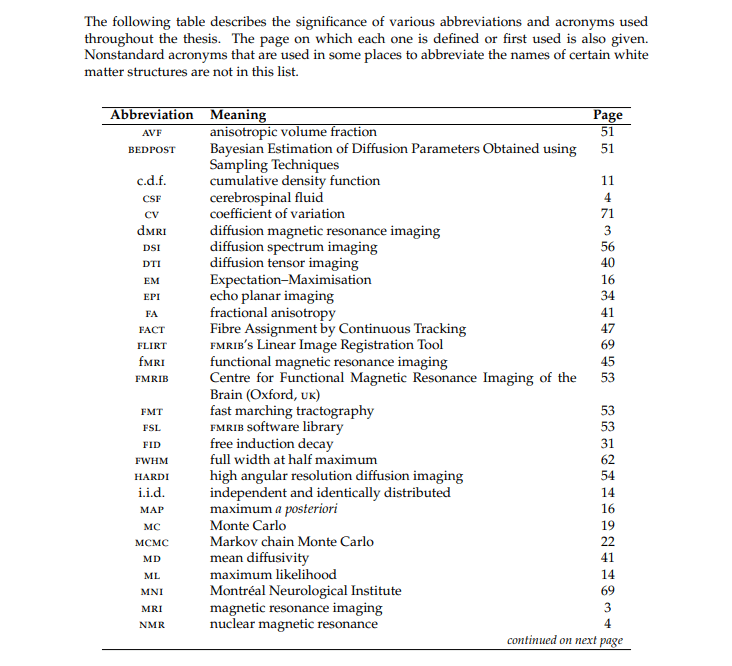
The above example has been extracted from here .
List of Symbols
You can add symbols and their definitions to your list of abbreviations, however, some people like to keep them separate, especially if they have many of them. While this format will come down to personal preference, most STEM students create a separate list of symbols and most non-STEM students incorporate them into their list of abbreviations.
Note: If you are writing your report to APA style, you will need to consider additional requirements when writing your list of abbreviations. You can find further information here .
Further Reading
Whether you’re writing a Ph.D. thesis or a dissertation paper, the following resources will also be of use:
- Title Page for an Academic Paper
- List of Appendices
Finding a PhD has never been this easy – search for a PhD by keyword, location or academic area of interest.

This post gives you the best questions to ask at a PhD interview, to help you work out if your potential supervisor and lab is a good fit for you.

In this post you’ll learn what the significance of the study means, why it’s important, where and how to write one in your paper or thesis with an example.

In Finland, all new PhD holders are given a traditional Doctoral Hat and Doctoral Sword during a Conferment Ceremony, symbolising the freedom of research.
Join thousands of other students and stay up to date with the latest PhD programmes, funding opportunities and advice.

Browse PhDs Now

PhD stress is real. Learn how to combat it with these 5 tips.

There’s no doubt about it – writing can be difficult. Whether you’re writing the first sentence of a paper or a grant proposal, it’s easy

Lewis is a third-year PhD student at CVSSP at the University of Surrey. His research involves using multi-camera broadcast footage of sports, and using this data to create new viewpoints in virtual and augmented reality.

Sara is currently in the 4th year of the Physics Doctoral Program at The Graduate Center of the City University of New York. Her research investigates quantum transport properties of 2D electron systems.
Join Thousands of Students
Purdue Online Writing Lab Purdue OWL® College of Liberal Arts
MLA Abbreviations

Welcome to the Purdue OWL
This page is brought to you by the OWL at Purdue University. When printing this page, you must include the entire legal notice.
Copyright ©1995-2018 by The Writing Lab & The OWL at Purdue and Purdue University. All rights reserved. This material may not be published, reproduced, broadcast, rewritten, or redistributed without permission. Use of this site constitutes acceptance of our terms and conditions of fair use.
There are a few common trends in abbreviating that you should follow when using MLA, though there are always exceptions to these rules. For a complete list of common abbreviations used in academic writing, see Appendix 1 in the MLA Handbook (9 th ed.).
Uppercase letter abbreviations
Do not use periods or spaces in abbreviations composed solely of capital letters, except in the case of proper names:
unless the name is only composed of initials:
Lowercase letter abbreviations
Use a period if the abbreviation ends in a lowercase letter, unless referring to an Internet suffix, where the period should come before the abbreviation:
Note: Degree names are a notable exception to the lowercase abbreviation rule.
Use periods between letters without spacing if each letter represents a word in common lowercase abbreviations:
Other notable exceptions:
Abbreviations in citations
Condense citations as much as possible using abbreviations.
Time Designations
Remember to follow common trends in abbreviating time and location within citations. Month names longer than four letters used in journal and magazine citations should be abbreviated:
Geographic Names
Use geographic names of states and countries. Abbreviate country, province, and state names.
Scholarly Abbreviations
The MLA Handbook (9 th ed.) encourages users to adhere to the common scholarly abbreviations for both in-text citations and in the works-cited page. Here is the list of common scholarly abbreviations from Appendix 1 of the MLA Handbook (9 th ed.) with a few additions:
- anon. for anonymous
- app. for appendix
- bk. for book
- c. or ca. for circa
- ch. for chapter
- col. for column
- def. for definition
- dept. for department
- e.g. for example
- ed. for edition
- et al. for multiple names (translates to "and others")
- etc. for "and so forth"
- fig. for figure
- fwd. for foreword
- i.e. for that is
- jour. for journal
- lib. for library
- MS, MSS for manuscript(s)
- no. for number
- P for Press (used for academic presses)
- p. for page, pp. for pages
- par. for paragraph when page numbers are unavailable
- qtd. in for quoted in
- rev. for revised
- sec. or sect. for section
- ser. for series
- trans. for translation
- U for University (for example, Purdue U)
- UP for University Press (for example, Yale UP or U of California P)
- vers. for version
- var. for variant
- vol. for volume
Publisher Names
Cite publishers’ names in full as they appear on title or copyright pages. For example, cite the entire name for a publisher (e.g. W. W. Norton or Liveright Publishing).
Exceptions:
- Omit articles and business abbreviations (like Corp., Inc., Co., and Ltd.).
- Use the acronym of the publisher if the company is commonly known by that abbreviation (e.g. MLA, ERIC, GPO). For publishers who are not known by an abbreviation, write the entire name.
- Use only U and P when referring to university presses (e.g. Cambridge UP or U of Arkansas P)
For more information on scholarly abbreviations, see Appendix 1 of the MLA Handbook (9 th ed.) . See also the following examples:
Using abbreviations in scientific papers
It’s time to know more about abbreviations in scientific papers and learn ways to avoid mistakes when using them.
The use of abbreviations in academic and scientific publications is common, but authors are often asked to keep their usage as brief as possible.
They are usually limited to universal abbreviations for weights and measurements. We would like to provide some tips in this article on how to use abbreviations effectively in your writing.
If you are going to use abbreviations in scientific papers , then you should pay attention to the following tips.
What do abbreviations in scientific papers mean?
Abbreviations are shortened versions of terms and phrases, such as kg for kilograms, CEO for chief executive officer and Dr. for doctors. The use of abbreviations is ideally suited to situations in which you wish to reduce the number of words the text contains.
However, there is a tendency for abbreviations to be widely used in one field of study but unknown in another. It is important to use the article that corresponds to the pronounced form of the abbreviation
Are abbreviations allowed in research papers and where do you put them?
Your paper should include a list of abbreviations at the beginning of each of the following segments: heading, abstract, text, and figure/table legends.
A common rule of thumb is to write all non-standard abbreviations in their entirety on their first appearance both in abstracts and papers themselves.
After the first mention of an abbreviation, it is essential that you use it frequently. Additionally, the format should be consistently followed throughout the paper.
Abbreviations and acronyms: what’s the difference?
The terms abbreviation and acronym are both shorthand versions of words and phrases. While abbreviations shorten longer words (like Dr. or Prof.), acronyms use the first letter of each word in a phrase to create a new word (like NASA or FBI).
There is a difference between abbreviations and acronyms, even though authors often use them the same way. An acronym, initialism, or other word contraction form is an abbreviation.
Acronyms are abbreviations formed by condensing the first letters of multiple words into one. Although not all abbreviations are acronyms, all acronyms are abbreviations. Abbreviations and acronyms differ primarily in this regard.
The most common mistakes to avoid when using abbreviations
Abbreviation errors in academic publications are sometimes common. The following are a few ways you can avoid this from happening in the future.
- It is usually advisable to define abbreviations only once when you decide to use them. Exceptions do exist, however. An abbreviation may be used at the beginning of a section in a report or chapter in a book.
- Having an inconsistent approach is the top mistake you can make. The journals will provide guidelines on how to submit your work, so please read them carefully. Generally, abbreviations in scholarly articles are introduced only after three or more instances of the term.
- It is important to use standard abbreviations if you are writing in a field that uses them – for instance, elements in the physical sciences are often abbreviated for word count constraints. Standard formatting should always be used (both spelling and case-sensitive formatting). Capitalization is typically used only for proper nouns.
- Remember that for well-known abbreviations, lowercase is recommended over uppercase for competing terms, if the same letters are used in other abbreviations in the manuscript.
- The abbreviation “et al.” can be confusing to use in scientific writing because it is often misspelt or misused. As the name suggests, this term means “and others”. In-text citations or references are often shortened with this abbreviation, and it can be used wherever it precedes a name in the text.
Here is a list of some scientific abbreviations
| DNA | Deoxyribonucleic acid |
| NASA | National Aeronautics and Space Administration |
| PBA | Process Behaviour Analysis |
| QA | Quality Assurance |
| Fig. | Figure |
| MRI | Magnetic resonance imaging |
| ML | Maximum Likelihood |
| AI | Artificial Intelligence |
| CSF | Cerebrospinal Fluid |
| ANOVA | Analysis of variance |
And the list goes on.
A professional graphical abstract that doesn’t require any effort
When you use Mind the Graph , you can make a fantastic graphical abstract in a short amount of time. What’s the hold up, well don’t wait any longer, use it today for free!
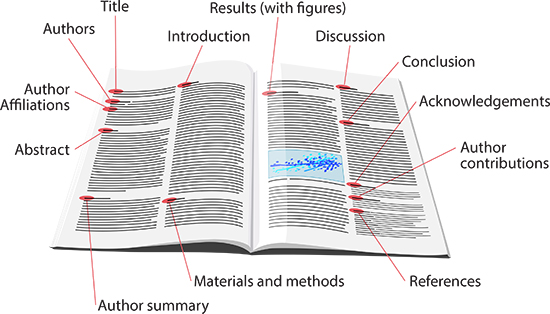
Subscribe to our newsletter
Exclusive high quality content about effective visual communication in science.
Sign Up for Free
Try the best infographic maker and promote your research with scientifically-accurate beautiful figures
no credit card required
About Aayushi Zaveri
Aayushi Zaveri majored in biotechnology engineering. She is currently pursuing a master's degree in Bioentrepreneurship from Karolinska Institute. She is interested in health and diseases, global health, socioeconomic development, and women's health. As a science enthusiast, she is keen in learning more about the scientific world and wants to play a part in making a difference.
Content tags

5 Quick Tips for Using Abbreviations and Acronyms in Academic Writing
Whether you’re working on a thesis or a research paper, abbreviations and acronyms are difficult to avoid in academic writing, which is why it’s important that you know how to use them properly. Here’s a quick primer.
1. Spell the word or phrase in full at first mention
When you first use the term that you will be abbreviating, you should usually spell out the actual word or phrase in full and follow that with the abbreviation/acronym in brackets.
For example: “We then conducted an analysis of variance (ANOVA).”
This ensures that your reader understands what your abbreviation means. While some abbreviations may seem common or obvious, different disciplines may use the same shorthand for different phrases. For example, “CAD” could refer to computer-aided design, coronary artery disease, Canadian dollar, current account deficit… You get the point! Abbreviations or acronyms that are extremely common for your audience may not need to be defined, but it’s best to check your style guidelines on this—and if you’re unsure, err on the side of caution and provide the full version at first mention.
2. Make sure abbreviations appear more than once
If you find that you have only used a specific abbreviation once in the entire paper, you should use the full version of the word or phrase instead and delete the abbreviation. This is because the purpose of abbreviations and acronyms is to make the writing more concise and aid comprehension, so—bearing in mind that it’s good practice to spell the abbreviated word or phrase in full at first mention—if it is only used once the abbreviation is redundant.

3. Use abbreviations consistently
Once you have introduced an abbreviation, it should be used consistently throughout the rest of the piece—that is, every time the word or phrase appears following its introduction. This means that once you have defined the abbreviation, you should stick to the same format and not switch back to the full word or a different abbreviation elsewhere in the paper. There are some exceptions to this rule; for example, the original text should be retained in direct quotations and references, and you may wish to use the full version in tables, figures, and section headings, depending on whether your style guide permits or even prescribes this.
4. Don’t go overboard
Abbreviations are a great way to keep writing concise. They can help you meet a tight word count, and enable the reader to focus on important information without getting bogged down by cumbersome phrases (for example, it’s much easier to process “RMSEA” than “root mean square error of approximation”!). However, a good writer will be prudent in their use of abbreviations; if a paper contains too many, that can be distracting and confusing in itself. Bear in mind also that similar constructions should be avoided. For example, if both “CAD” and “CDA” appear in your paper, it may be better to modify one of the abbreviations, or use the full version for one of the terms and do away with that abbreviation altogether.
5. Let us help!
Practice common sense, stick to the rules above, and, as always, feel free to have us check your work prior to submission to make sure your abbreviations are working with your paper rather than against it. Among our usual checks, we’ll ensure abbreviations are appropriate and consistent, and in line with your style guidelines.
- Academic Editing Services
- Theses and Dissertations
- Discounts for High-Volume Clients
- Submit Work and Get an Instant Quote
- Theses & Dissertations
- Translation
- Why We’re Different
- Work for Us
- Learn How to Become a Proofreader
- Academic Resources
- Submit Work & Contact
- How it works

List of Abbreviations for Dissertation
Published by Owen Ingram at August 11th, 2021 , Revised On August 22, 2023
What are Abbreviations?
“Oxford English Dictionary defines an abbreviation as ‘a short form of a word’. For example, UN is the short form – an abbreviation – for United Nations.” Abbreviations are commonly used in every form of writing, including academic writing. Abbreviations in dissertations generally have to do with names of organisations, institutions, theoretical models and the like.
If your dissertation includes many abbreviations, it will make sense to define all these abbreviations in an alphabetically-organised list.
This can really help your readers understand the jargon and specific terms they might not be familiar with. Here is all you need to know about the list of abbreviations for the dissertation .
Placement of a List of Abbreviations
Abbreviations’ list should be placed at the start of the dissertation and right after the table of contents . The list of abbreviations should also be a part of the table of contents. If you aren’t using many abbreviations, there isn’t a need to include a whole list. Underneath, we will guide you on how to define abbreviations within the text.
| Abbreviation | Full Form |
|---|---|
| Association | |
| Corporation | |
| Limited | |
| Bookkeeper | |
| Doctor | |
| For Example |
Abbreviations don’t need to be numbered in the list.
Acronyms and Abbreviations
There are various ways of placing acronyms and abbreviations in a dissertation. While using acronyms formed by combining the first letter of each word from a phrase, you should write that phrase in its full form and then write the abbreviation in parenthesis right after that. You can then make use of that acronym for the rest of the dissertation .
Acronyms Example in a dissertation
I met the regional sales manager (RSM) of 5 different multi-national companies (MNC). I conducted in-depth interviews with the RSM, through which I came to know that every MNC has a different strategy for its product marketing.
Some exceptions don’t apply to this rule, such as when acronyms like AI, URL, FIFA, etc. are involved You can still write the full acronym if unsure.
Point to remember: In research, it is not considered right to create your own abbreviations and/or acronyms. You can only abbreviate terms that have officially been abbreviated in books, journals and other published materials. For instance, you cannot abbreviate ‘women leaders in private sectors’ to ‘WLiPS’. Unless such an abbreviation actually exists, this would be unethical in the context of research.
Looking for dissertation help?
Researchprospect to the rescue then.
We have expert writers on our team who are skilled at helping students with quantitative dissertations across a variety disciplines. Guaranteeing 100% satisfaction!

APA Style of Abbreviations
If you are working with APA referencing style, there are additional and specific requirements for creating a list of abbreviations for the dissertation.
Other Types of Lists in a Dissertation
In addition to the list of abbreviations, there are other lists that you can include in your dissertation paper, including:
- Table of Contents
- Figures and tables
Point to note: You might come across some types of research or theses where the abbreviations’ column is placed in front of an ‘explanation’ column. The latter is simply another way of ‘defining’ the acronyms/abbreviations or rather, giving their full forms. Here is an example of such a list of abbreviations from a thesis:
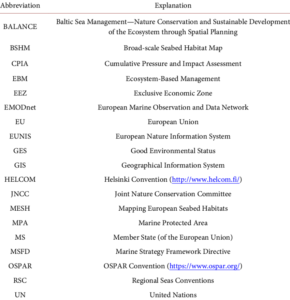
How can ResearchProspect Help?
Whether you need help with the list of abbreviations or any other aspect of your dissertation paper, ResearchProspect dissertation services are designed to help you achieve a high academic grade. Our strict recruitment process helps us to hire the best of the best dissertation writers .
Place Your Order Now LEARN MORE ABOUT OUR DISSERTATION SERVICES
Frequently Asked Questions
What is a list of abbreviations.
A list of abbreviations is a compilation of shortened forms used in a document, often found at the beginning or end. It explains the meanings of acronyms, initialisms, or shortened terms to help readers comprehend the text more easily.
You May Also Like
Dissertation conclusion is perhaps the most underrated part of a dissertation or thesis paper. Learn how to write a dissertation conclusion.
Your dissertation introduction chapter provides detailed information on the research problem, significance of research, and research aim & objectives.
Stuck on the recommendations section of your research? Read our guide on how to write recommendations for a research study and get started.
USEFUL LINKS
LEARNING RESOURCES

COMPANY DETAILS

- How It Works

Style Guide for Research Papers: Abbreviations
- Style & Format
- Citing the Bible
- Footnotes & Bibliography
- Citing Books
- Citing Commentaries
- Citing Dictionaries/Encyclopedias
- Citing Journals
- Citing Lexicons
- Citing Digital Media
- Abbreviations
- Model Title Page
Documentation and Abbreviations
The SBL Handbook of Style offers two extensive lists of abbreviations for journals, series, and other standard reference works. The first abbreviation list is alphabetized by source ( SBLHS 8.4.1) and the second by abbreviation ( SBLHS 8.4.2). If the work cited is in these lists, you may use the standard abbreviation provided.
Note that both lists italicize abbreviations of journal titles and abbreviations based on book titles (e.g., JBL, COS ), but do not italicize the abbreviations of book series (e.g., WGRW, JSOTSup) or abbreviations based on personal names (e.g., BAGD, BDB). If a work is not included in the abbreviation lists of SBLHS or some other authoritative resource (e.g., IATG , CAD ), use complete titles throughout or include a list of additional abbreviations on a separate page at the beginning of the paper (after the title page and before the main text). A partial list of abbreviations is included at the end of this style guide.
Biblical Abbreviations
Abbreviations follow the format recommended by the Society of Biblical Literature
| Name | Abbreviation |
|---|---|
| Genesis | Gen |
| Exodus | Exod |
| Leviticus | Lev |
| Numbers | Num |
| Deuteronomy | Deut |
| Joshua | Josh |
| Judges | Judg |
| Ruth | Ruth |
| 1-2 Samuel | 1-2 Sam |
| 1-2 Kings | 1-2 Kgs |
| 1-2 Chronicles | 1-2 Chr |
| Ezra | Ezra |
| Nehemiah | Neh |
| Esther | Esth |
| Job | Job |
| Psalms | Ps/Pss |
| Proverbs | Prov |
| Ecclesiastes | Eccl/Qoh |
| Song of Songs/Solomon | Song/Cant |
| Isaiah | Isa |
| Jeremiah | Jer |
| Lamentations | Lam |
| Ezekiel | Ezek |
| Daniel | Dan |
| Hosea | Hos |
| Joel | Joel |
| Amos | Amos |
| Obadiah | Obad |
| Jonah | Jonah |
| Micah | Mic |
| Nahum | Nah |
| Habakkuk | Hab |
| Zephaniah | Zeph |
| Haggai | Hag |
| Zechariah | Zech |
| Malachi | Mal |
| Name | Abbreviation |
|---|---|
| Matthew | Matt |
| Mark | Mark |
| Luke | Luke |
| John | John |
| Acts | Acts |
| Romans | Rom |
| 1-2 Corinthians | 1-2 Cor |
| Galatians | Gal |
| Ephesians | Eph |
| Philippians | Phil |
| Colossians | Col |
| 1-2 Thessalonians | 1-2 Thess |
| 1-2 Timothy | 1-2 Tim |
| Titus | Titus |
| Philemon | Phlm |
| Hebrews | Heb |
| James | Jas |
| 1-2 Peter | 1-2 Pet |
| 1-3 John | 1-3 John |
| Jude | Jude |
| Revelation | Rev |
Abbreviations for Bible Versions
| Amplified Bible | AMP |
| American Standard Version | ASV |
| Biblia Hebraica Stuttgartensia (Hebrew Bible) | BHS |
| Common English Bible | CEB |
| Contemporary English Version | CEV |
| Christian Standard Bible | CSB |
| English Standard Version | ESV |
| Good News Bible | GNB |
| Holman Christian Standard Bbile | HCSB |
| Jerusalem Bible | JB |
| King James Version | KJV |
| Living Bible | LB |
| Lexham English Bible | LEB |
| Septuagint (Greek translation of the Hebrew Bible) | LXX |
| Modern Language Bible | MLB |
| New Testament: A New Translation, James Moffatt | MOFFATT |
| Message | MSG |
| Masoretic Text | MT |
| Nestle-Aland Greek New Testament, 28th Edition | NA28 |
| New American Bible, Revised Edition | NASR |
| New American Standard Bible | NASB |
| New American Version | NAV |
| New Century Version | NCV |
| New English Bible | NET |
| New English Translation of the Septuagint | NETS |
| New International Reader's Version | NIrV |
| New International Version | NIV |
| New Jerusalem Bible | NJB |
| Tanakh: The Holy Scriptures: The New JPS Translation | NJPS |
| New King James Version | NKJV |
| New Living Translation | NLT |
| New Revised Standard Version | NRSV |
| New Testament in Modern English, J.B. Phillips | PHILLIPS |
| Revised English Bible | REB |
| Revised Standard Version | RSV |
| Today's English Version (also known as Good News Bible) | TEV |
| Today's Living Bible | TLB |
| Today's New International Version | TNIV |
| Vulgate | VUL |
| World English Bible | WEB |
| New Testament in Modern Speech, R. F. Weymouth | WEYMOUTH |
| Young's Literal Translation | YLT |
Journal Abbreviations
The following is only a partial list of abbreviations for journals. See the SBL Handbook of Style for a more complete list.
| African Journal of Evangelical Theology | AJET |
| Asbury Theological Journal | AsTJ |
| Asia Journal of Theology | AJT |
| Asian Journal of Pentecostal Studies | AJPS |
| Biblica | Bib |
| Biblical Archaeology Review | BAR |
| Biblical Theology Bulletin | BTB |
| Bibliotheca Sacra | BSas |
| Bulletin of the American Schools of Oriental Research | BASOR |
| Calvin Theological Journal | CTJ |
| Catholic Biblical Quarterly | CBQ |
| Church History | CH |
| European Journal of Theology | EuroJTh |
| Harvard Theological Review | HTR |
| Hebrew Bible and Ancient Israel | HeBAI |
| Horizons in Biblical Theology | HBT |
| Interpretation: A Journal of Bible and Theology | Int |
| Journal for the Study of the New Testament | JSNT |
| Journal for the Study of the Old Testament | JSOT |
| Journal of Biblical and Pneumatological Research | JBPR |
| Journal of Biblical Literature | JBL |
| Journal of Early Christian Studies | JECS |
| Journal of Pentecostal Theology | JPS |
| Journal of the Evangelical theological Society | JETS |
| Journal fo the Jesus Movement in Its Jewish Setting | JJMJS |
| Journal of Religious Ethics | JORE |
| Near Eastern Archaeology | NEA |
| New Testament Studies | NTS |
| Novum Testamentum | NovT |
| Pneuma: The Journal of the Society for Pentecostal Studies | Pneuma |
| Scottish Journal of Theology | SJT |
| Southern Baptist Journal of Theology | SBJT |
| Southwestern Journal of Theology | SWJT |
| Trinity Journal | TJ |
| Westminster Theological Journal | WTJ |
Commentary Abbreviations
The following is only a partial list of abbreviations for commentaries. See the SBL Handbook of Style for a more complete list.
| Abingdon New Testament Commentaries | ANTC |
| Abingdon Old Testament Commentaries | AOTC |
| Anchor Bible (or Anchor Yale Bible) | AB (or AYBC) |
| Ancient Christian Commentary Series | ACCS |
| Apollos Old Testament Commentary | ApOTC |
| Augsburg Commentary on the New Testament | ACNT |
| Baker Exegetical Commentary on the NT | BECNT |
| Bible Knowledge Commentary | BKC |
| Bible Speaks Today | BST |
| Black's New Testament Commentaries | BNTC |
| Brazos Theological Commentaries | BTC |
| Eerdmans Critical Commentary | ECC |
| Expositor's Bible Commentary (and revised version) | EBC (or REBC) |
| Hermeneia | Hermeneia |
| International Critical Commentary | ICC |
| Interpretation: A Bible Commentary for Preaching and Teaching | IBC |
| IVP New Testament Commentary | IVPNTC |
| Keil and Delitzsch Commentary | K&D |
| New American Commentary | NAC |
| New Cambridge Bible Commentary | NCBC |
| New Century Bible | NCB |
| New International Biblical Commentary on the NT | NIBCNT |
| New International Biblical Commentary on the OT | NIBCOT |
| New International Commentary on the NT | NICNT |
| New International Commentary on the OT | NICOT |
| New International Greek Testament Commentary | NIGTC |
| New Interpreter's Bible | NIB |
| New Jerome Bible Commentary | NJBC |
| New Testament Library | NTL |
| NIV Application Commentary | NIVAC |
| Old Testament Library | OTL |
| Paideia Commentaries on the New Testament | PCNT |
| Pillar New Testament Commentary | PNTC |
| Socio-Rhetorical Commentary | SRC |
| Tyndale New Testament Commentaries | TNTC |
| Tyndale Old Testament Commentaries | TOTC |
| Word Biblical Commentary | WBC |
| Zondervan Exegetical Commentary on the New Testament | ZECNT |
| Zondervan Exegetical Commentary on the Old Testament | ZECOT |
| Zondervan Illustrated Bible Backgrounds Commentary | ZIBBC |
Publisher Abbreviations
The following is only a partial list of abbreviations for publishing houses. For a full explanation of the proper way to cite publishers, see the Society of Biblical Literature Handbook of Style, 2nd edition, section 6.1.4.
The left column in the following list includes the full publishing house names, followed in parentheses by the main city or cities where they are located. Cities in the list that are followed by their state abbreviation will require that state abbreviation in the footnotes and bibliography of your papers.
The right column in the following list shows how the publishers should be cited in the footnotes and bibliography. The city is always required, followed by a colon, followed by the standardized name of the publishing company. When citing a publishing house, only use the first city that is listed in title page or copyright page of the actual book you used. Do not include terms such as "Press," "Publisher," or "Publishing House" in your citations unless that part of the publisher's name is required to avoid ambiguity from similarly-named publishing houses. Note that publishers such as Eerdmans , InterVarsity , and de Gruyter follow particular standardized rules.
| Abingdon (Nashville; New York) | Nashville: Abingdon |
| Apollos (Leicester) | Leicester: Apollos |
| Augsburg (Minneapolis) | Minneapolis: Augsburg |
| Augsburg Fortress (Minneapolis) | Minneapolis: Augsburg Fortress |
| Baker Academic (Grand Rapids) | Grand Rapids: Baker Academic |
| Baker Books (Grand Rapids) | Grand Rapids: Baker Books |
| Baylor University Press (Waco, TX) | Waco, TX: Baylor University Press |
| Bloomsbury (London; New Delhi; New York; Sydney) | London: Bloomsbury |
| Brazos (Grand Rapids) | Grand Rapids: Brazos |
| Brill (Leiden; Boston) | Leiden: Brill |
| Cambridge University Press (Cambridge: New York) | Cambridge: Cambridge University Press |
| Cascade (Eugene, OR) | Eugene, OR: Cascade |
| Crossway (Wheaton, IL) | Wheaton, IL: Crossway |
| de Gruyter (Berlin) | Berlin: de Gruyter |
| Deutsche Bibelgesellschaft (Stuttgart) | Stuttgart: Deutsche Bibelgesellschaft |
| Doubleday (Garden City, NY; New York) | New York: Doubleday |
| Eerdmans (Grand Rapids) | Grand Rapids: Eerdmans |
| E. J. Brill (see Brill, above) | |
| Fortress (Philadelphia) | Philadelphia: Fortress |
| Harper & Row (New York; San Francisco) | New York: Harper & Row |
| HarperCollins (New York: San Francisco) | New York: HarperCollins |
| HarperOne (San Francisco) | San Francisco: HarperOne |
| Harvard University Press (Cambridge) | Cambridge: Harvard University Press |
| Hendrickson (Peabody, MA) | Peabody, MA: Hendrickson |
| InterVarsity Press (Downers Grove, IL) | Downers Grove, IL: InterVarsity |
| Inter-Varsity Press (Leicester; London) | London: Inter-Varsity |
| John Knox (Atlanta; Richmond, VA) | Atlanta: John Knox |
| Kregel (Grand Rapids) | Grand Rapids: Kregel |
| Mercer University Press (Macon, GA) | Macon, GA: Mercer University Press |
| Mohr Siebeck (Tübingen) | Tübingen: Mohr Siebeck |
| Nelson (Nashville; London) | Nashville: Nelson |
| Orbis Books (Maryknoll, NY) | Maryknoll, NY: Orbis Books |
| Oxford University Press (Oxford; London; New York) | Oxford: Oxford University Press |
| Paternoster (Exeter; Milton Keynes) | Exeter: Paternoster |
| Paulist (New York: Mahwah, NJ) | New York: Paulist |
| Peeters (Leuven) | Leuven: Peeters |
| Penguin Books (Harmondsworth; London) | London: Penguin Books |
| Pickwick (Pittsburgh; Eugene, OR) | Pittsburgh: Pickwick |
| Prentice Hall (Englewood Cliffs, NJ; Upper Saddle River, NJ) | Upper Saddle River, NJ: Prentice Hall |
| Princeton University Press (Princeton) | Princeton: Princeton University Press |
| Rowman & Littlefield (Lanham, MD) | Lanham, MD: Rowman & Littlefield |
| SBL Press (Atlanta) | Atlanta: SBL Press |
| Scholars Press (Missoula, MT; Chico, CA; Atlanta) | Atlanta: Scholars Press |
| SCM (London) | London: SCM |
| Scribner’s Sons (New York) | New York: Scribner's Sons |
| Sheffield Academic (Sheffield) | Sheffield: Sheffield Academic |
| Sheffield Phoenix (Sheffield) | Sheffield: Sheffield Phoenix |
| SIL International (Dallas) | Dallas: SIL International |
| Smyth & Helwys (Macon, GA) | Macon, GA: Smyth & Helwys |
| Society of Biblical Literature (Atlanta) | Atlanta: Society of Biblical Literature |
| Society for Promoting Christian Knowledge (see SPCK) | |
| SPCK (London) | London: SPCK |
| T&T Clark (Edinburgh; London; New York) | New York: T&T Clark |
| Thomas Nelson (see Nelson, above) | |
| Tyndale House (Carol Stream, IL) | Carol Stream, IL: Tyndale House |
| Tyndale Press (London) | London: Tyndale Press |
| United Bible Societies (London; New York; Stuttgart) | New York: United Bible Societies |
| Walter de Gruyter (see de Gruyter) | |
| Westminster (Philadelphia) | Philadelphia: Westminster |
| Westminster John Knox (Louisville) | Louisville: Westminster John Knox |
| Wiley & Sons (New York) | New York: Wiley & Sons |
| Wiley-Blackwell (Malden, MA; Chichester) | Malden, MA: Wiley-Blackwell |
| William B. Eerdmans (see Eerdmans, above) | |
| Wm. B. Eerdmans (see Eerdmans, above) | |
| Wipf & Stock (Eugene, OR) | Eugene, OR: Wipf & Stock |
| Word (Waco, TX; Dallas; Nashville) | Dallas: Word |
| Yale University Press (New Haven) | New Haven: Yale University Press |
| Zondervan (Grand Rapids) | Grand Rapids: Zondervan |
- << Previous: Citing Digital Media
- Next: Model Title Page >>
- Last Updated: Apr 3, 2024 4:13 PM
- URL: https://sagu.libguides.com/styleguide
Frequently asked questions
What is a list of abbreviations.
A list of abbreviations is a list of all the abbreviations that you used in your thesis or dissertation. It should appear at the beginning of your document, with items in alphabetical order, just after your table of contents .
Frequently asked questions: Dissertation
Dissertation word counts vary widely across different fields, institutions, and levels of education:
- An undergraduate dissertation is typically 8,000–15,000 words
- A master’s dissertation is typically 12,000–50,000 words
- A PhD thesis is typically book-length: 70,000–100,000 words
However, none of these are strict guidelines – your word count may be lower or higher than the numbers stated here. Always check the guidelines provided by your university to determine how long your own dissertation should be.
A dissertation prospectus or proposal describes what or who you plan to research for your dissertation. It delves into why, when, where, and how you will do your research, as well as helps you choose a type of research to pursue. You should also determine whether you plan to pursue qualitative or quantitative methods and what your research design will look like.
It should outline all of the decisions you have taken about your project, from your dissertation topic to your hypotheses and research objectives , ready to be approved by your supervisor or committee.
Note that some departments require a defense component, where you present your prospectus to your committee orally.
A thesis is typically written by students finishing up a bachelor’s or Master’s degree. Some educational institutions, particularly in the liberal arts, have mandatory theses, but they are often not mandatory to graduate from bachelor’s degrees. It is more common for a thesis to be a graduation requirement from a Master’s degree.
Even if not mandatory, you may want to consider writing a thesis if you:
- Plan to attend graduate school soon
- Have a particular topic you’d like to study more in-depth
- Are considering a career in research
- Would like a capstone experience to tie up your academic experience
The conclusion of your thesis or dissertation should include the following:
- A restatement of your research question
- A summary of your key arguments and/or results
- A short discussion of the implications of your research
The conclusion of your thesis or dissertation shouldn’t take up more than 5–7% of your overall word count.
For a stronger dissertation conclusion , avoid including:
- Important evidence or analysis that wasn’t mentioned in the discussion section and results section
- Generic concluding phrases (e.g. “In conclusion …”)
- Weak statements that undermine your argument (e.g., “There are good points on both sides of this issue.”)
Your conclusion should leave the reader with a strong, decisive impression of your work.
While it may be tempting to present new arguments or evidence in your thesis or disseration conclusion , especially if you have a particularly striking argument you’d like to finish your analysis with, you shouldn’t. Theses and dissertations follow a more formal structure than this.
All your findings and arguments should be presented in the body of the text (more specifically in the discussion section and results section .) The conclusion is meant to summarize and reflect on the evidence and arguments you have already presented, not introduce new ones.
A theoretical framework can sometimes be integrated into a literature review chapter , but it can also be included as its own chapter or section in your dissertation . As a rule of thumb, if your research involves dealing with a lot of complex theories, it’s a good idea to include a separate theoretical framework chapter.
A literature review and a theoretical framework are not the same thing and cannot be used interchangeably. While a theoretical framework describes the theoretical underpinnings of your work, a literature review critically evaluates existing research relating to your topic. You’ll likely need both in your dissertation .
While a theoretical framework describes the theoretical underpinnings of your work based on existing research, a conceptual framework allows you to draw your own conclusions, mapping out the variables you may use in your study and the interplay between them.
A thesis or dissertation outline is one of the most critical first steps in your writing process. It helps you to lay out and organize your ideas and can provide you with a roadmap for deciding what kind of research you’d like to undertake.
Generally, an outline contains information on the different sections included in your thesis or dissertation , such as:
- Your anticipated title
- Your abstract
- Your chapters (sometimes subdivided into further topics like literature review , research methods , avenues for future research, etc.)
When you mention different chapters within your text, it’s considered best to use Roman numerals for most citation styles. However, the most important thing here is to remain consistent whenever using numbers in your dissertation .
In most styles, the title page is used purely to provide information and doesn’t include any images. Ask your supervisor if you are allowed to include an image on the title page before doing so. If you do decide to include one, make sure to check whether you need permission from the creator of the image.
Include a note directly beneath the image acknowledging where it comes from, beginning with the word “ Note .” (italicized and followed by a period). Include a citation and copyright attribution . Don’t title, number, or label the image as a figure , since it doesn’t appear in your main text.
Definitional terms often fall into the category of common knowledge , meaning that they don’t necessarily have to be cited. This guidance can apply to your thesis or dissertation glossary as well.
However, if you’d prefer to cite your sources , you can follow guidance for citing dictionary entries in MLA or APA style for your glossary.
A glossary is a collection of words pertaining to a specific topic. In your thesis or dissertation, it’s a list of all terms you used that may not immediately be obvious to your reader. In contrast, an index is a list of the contents of your work organized by page number.
The title page of your thesis or dissertation goes first, before all other content or lists that you may choose to include.
The title page of your thesis or dissertation should include your name, department, institution, degree program, and submission date.
Glossaries are not mandatory, but if you use a lot of technical or field-specific terms, it may improve readability to add one to your thesis or dissertation. Your educational institution may also require them, so be sure to check their specific guidelines.
A glossary or “glossary of terms” is a collection of words pertaining to a specific topic. In your thesis or dissertation, it’s a list of all terms you used that may not immediately be obvious to your reader. Your glossary only needs to include terms that your reader may not be familiar with, and is intended to enhance their understanding of your work.
A glossary is a collection of words pertaining to a specific topic. In your thesis or dissertation, it’s a list of all terms you used that may not immediately be obvious to your reader. In contrast, dictionaries are more general collections of words.
An abbreviation is a shortened version of an existing word, such as Dr. for Doctor. In contrast, an acronym uses the first letter of each word to create a wholly new word, such as UNESCO (an acronym for the United Nations Educational, Scientific and Cultural Organization).
As a rule of thumb, write the explanation in full the first time you use an acronym or abbreviation. You can then proceed with the shortened version. However, if the abbreviation is very common (like PC, USA, or DNA), then you can use the abbreviated version from the get-go.
Be sure to add each abbreviation in your list of abbreviations !
If you only used a few abbreviations in your thesis or dissertation , you don’t necessarily need to include a list of abbreviations .
If your abbreviations are numerous, or if you think they won’t be known to your audience, it’s never a bad idea to add one. They can also improve readability, minimizing confusion about abbreviations unfamiliar to your reader.
Your list of tables and figures should go directly after your table of contents in your thesis or dissertation.
Lists of figures and tables are often not required, and aren’t particularly common. They specifically aren’t required for APA-Style, though you should be careful to follow their other guidelines for figures and tables .
If you have many figures and tables in your thesis or dissertation, include one may help you stay organized. Your educational institution may require them, so be sure to check their guidelines.
A list of figures and tables compiles all of the figures and tables that you used in your thesis or dissertation and displays them with the page number where they can be found.
The table of contents in a thesis or dissertation always goes between your abstract and your introduction .
You may acknowledge God in your dissertation acknowledgements , but be sure to follow academic convention by also thanking the members of academia, as well as family, colleagues, and friends who helped you.
A literature review is a survey of credible sources on a topic, often used in dissertations , theses, and research papers . Literature reviews give an overview of knowledge on a subject, helping you identify relevant theories and methods, as well as gaps in existing research. Literature reviews are set up similarly to other academic texts , with an introduction , a main body, and a conclusion .
An annotated bibliography is a list of source references that has a short description (called an annotation ) for each of the sources. It is often assigned as part of the research process for a paper .
In a thesis or dissertation, the discussion is an in-depth exploration of the results, going into detail about the meaning of your findings and citing relevant sources to put them in context.
The conclusion is more shorter and more general: it concisely answers your main research question and makes recommendations based on your overall findings.
In the discussion , you explore the meaning and relevance of your research results , explaining how they fit with existing research and theory. Discuss:
- Your interpretations : what do the results tell us?
- The implications : why do the results matter?
- The limitation s : what can’t the results tell us?
The results chapter or section simply and objectively reports what you found, without speculating on why you found these results. The discussion interprets the meaning of the results, puts them in context, and explains why they matter.
In qualitative research , results and discussion are sometimes combined. But in quantitative research , it’s considered important to separate the objective results from your interpretation of them.
Results are usually written in the past tense , because they are describing the outcome of completed actions.
The results chapter of a thesis or dissertation presents your research results concisely and objectively.
In quantitative research , for each question or hypothesis , state:
- The type of analysis used
- Relevant results in the form of descriptive and inferential statistics
- Whether or not the alternative hypothesis was supported
In qualitative research , for each question or theme, describe:
- Recurring patterns
- Significant or representative individual responses
- Relevant quotations from the data
Don’t interpret or speculate in the results chapter.
To automatically insert a table of contents in Microsoft Word, follow these steps:
- Apply heading styles throughout the document.
- In the references section in the ribbon, locate the Table of Contents group.
- Click the arrow next to the Table of Contents icon and select Custom Table of Contents.
- Select which levels of headings you would like to include in the table of contents.
Make sure to update your table of contents if you move text or change headings. To update, simply right click and select Update Field.
All level 1 and 2 headings should be included in your table of contents . That means the titles of your chapters and the main sections within them.
The contents should also include all appendices and the lists of tables and figures, if applicable, as well as your reference list .
Do not include the acknowledgements or abstract in the table of contents.
The abstract appears on its own page in the thesis or dissertation , after the title page and acknowledgements but before the table of contents .
An abstract for a thesis or dissertation is usually around 200–300 words. There’s often a strict word limit, so make sure to check your university’s requirements.
In a thesis or dissertation, the acknowledgements should usually be no longer than one page. There is no minimum length.
The acknowledgements are generally included at the very beginning of your thesis , directly after the title page and before the abstract .
Yes, it’s important to thank your supervisor(s) in the acknowledgements section of your thesis or dissertation .
Even if you feel your supervisor did not contribute greatly to the final product, you must acknowledge them, if only for a very brief thank you. If you do not include your supervisor, it may be seen as a snub.
In the acknowledgements of your thesis or dissertation, you should first thank those who helped you academically or professionally, such as your supervisor, funders, and other academics.
Then you can include personal thanks to friends, family members, or anyone else who supported you during the process.
Ask our team
Want to contact us directly? No problem. We are always here for you.
- Email [email protected]
- Start live chat
- Call +1 (510) 822-8066
- WhatsApp +31 20 261 6040

Our team helps students graduate by offering:
- A world-class citation generator
- Plagiarism Checker software powered by Turnitin
- Innovative Citation Checker software
- Professional proofreading services
- Over 300 helpful articles about academic writing, citing sources, plagiarism, and more
Scribbr specializes in editing study-related documents . We proofread:
- PhD dissertations
- Research proposals
- Personal statements
- Admission essays
- Motivation letters
- Reflection papers
- Journal articles
- Capstone projects
Scribbr’s Plagiarism Checker is powered by elements of Turnitin’s Similarity Checker , namely the plagiarism detection software and the Internet Archive and Premium Scholarly Publications content databases .
The add-on AI detector is powered by Scribbr’s proprietary software.
The Scribbr Citation Generator is developed using the open-source Citation Style Language (CSL) project and Frank Bennett’s citeproc-js . It’s the same technology used by dozens of other popular citation tools, including Mendeley and Zotero.
You can find all the citation styles and locales used in the Scribbr Citation Generator in our publicly accessible repository on Github .
We use cookies to give you the best experience possible. By continuing we’ll assume you’re on board with our cookie policy

- A Research Guide
- Research Paper Guide
- Common & Uncommon Abbreviations for Research Papers
Common & Uncommon Abbreviations for Research Papers
- Common Abbreviations
Abbreviations of Degrees
Some common abbreviations.
| = compare | |
| = surgery, church | |
| = about | |
| = decreasing in loudness (music), | |
| = diminishing in loudness (music) | |
| = the same | |
| = for example | |
| = and elsewhere, Latin = and others | |
| = and so forth | = and the following, Latin or = and those that follow |
| = from the books of | |
| = loud (music) | |
| = very loud (music) | |
| = that you have the body | |
| = in the same place | |
| = the same | = that is |
| = let it be printed | |
| in the place cited | |
| pound | = in the place cited |
| = noon, meter, mile, minute, month | |
| = remember, memorandum | |
| = thousands | |
| = mark well, take notice | |
| it does not follow | |
| ) | |
| by the day | |
| for the time being | |
| = above), supreme | |
| = in the time of), tenor, tense (grammar), territory, time, ton(s), town, transitive, troy (weight) | |
| = see, voltage, von (German name) | |
| = namely | |
| = voice of the people | |
| = against | |
| = see above | |
For a complete list of Common Scholarly Abbreviations, please see Section 7.4 in the 6th edition of the MLA Handbook for Writers of Research Papers .
Note: When documenting sources using MLA style, the normal punctuation is omitted for degrees when used in parentheses, tables, works cited, footnotes, endnotes, etc. For example, B.A. is written as BA. Other abbreviations retain the periods if applicable, e.g. acad., bib., misc. Italics = Latin
| ) | ) |
| ) | |
| ) | |
Also, g reat post to read about US and Canada Map .
Links to Common, Uncommon, and Specialized Abbreviations
Acronym Finder . Look up acronyms, abbreviations and their meanings.
| |
Acronym Search . Your source for acronyms and abbreviations.
Common Abbreviations for posting messages on Bulletin Boards – from BabyCentre.co.uk. Examples: AKA = Also known as, LOL = Laughing out loud, BTW = By the way, CUL = See you later, Yw/Ty = You’re welcome/thank you. Emotions: 🙂 or 🙂 = Smiling (Happy), 🙁 or 🙁 = Frowning (Sad), 😮 = Shouting, xxooxxoo = Love (or hugs) & kisses. See also Shorthand and Meaning from Genealogy.com. (Scroll way down the page to view Shorthand). Examples: = I’m grinning, IMHO = in my humble opinion, FYI = for your information, FWIW = for what it’s worth, ROTFL = rolling on the floor laughing, WTG = way to go, Emotions: 😉 or 😉 = winking, 😀 or 😀 = laughing.
Common Abbreviations from Fact Monster for kids.
Common Abbreviations, Common Symbols, Acronyms for Organizations from Web-based Training Modules funded by the U.S. National Cancer Institute’s Surveillance, Epidemiology and End Results (SEER) Program.
Common Abbreviations from U.S. Department of State.
Common Abbreviations and Acronynms from AllEarsNet.com – Deb’s Unofficial Walt Disney World Information Guide.
Common Abbreviations in Writing.
Common Abbreviations Used in International Narcotics Control Strategy Report.
HyperWar – World War II on the WorldWideWeb – Abbreviations, Acronyms, Codewords, Terms .
Military Abbreviations and Acronyms of the US Armed Forces.
Also, great post to read concerning Abbreviations for Books of the Bible .
By clicking "Log In", you agree to our terms of service and privacy policy . We'll occasionally send you account related and promo emails.
Sign Up for your FREE account
Have a language expert improve your writing
Run a free plagiarism check in 10 minutes, automatically generate references for free.
- Knowledge Base
- Dissertation
- List of Abbreviations | Example, Template & Best Practices
List of Abbreviations | Example, Template & Best Practices
Published on 23 May 2022 by Tegan George . Revised on 25 October 2022.
A list of abbreviations is an alphabetical list of abbreviations that you can add to your thesis or dissertation. If you choose to include it, it should appear at the beginning of your document, just after your table of contents .
Abbreviation lists improve readability, minimising confusion about abbreviations unfamiliar to your reader. This can be a worthwhile addition to your thesis or dissertation if you find that you’ve used a lot of abbreviations in your paper.
If you only use a few abbreviations, you don’t necessarily need to include a list. However, it’s never a bad idea to add one if your abbreviations are numerous, or if you think they will not be known to your audience.
You can download our template below in the format of your choice to help you get started.
Download Word doc Download Google doc
Instantly correct all language mistakes in your text
Be assured that you'll submit flawless writing. Upload your document to correct all your mistakes.

- Table of contents
Example list of abbreviations
Best practices for abbreviations and acronyms, additional lists to include, frequently asked questions.
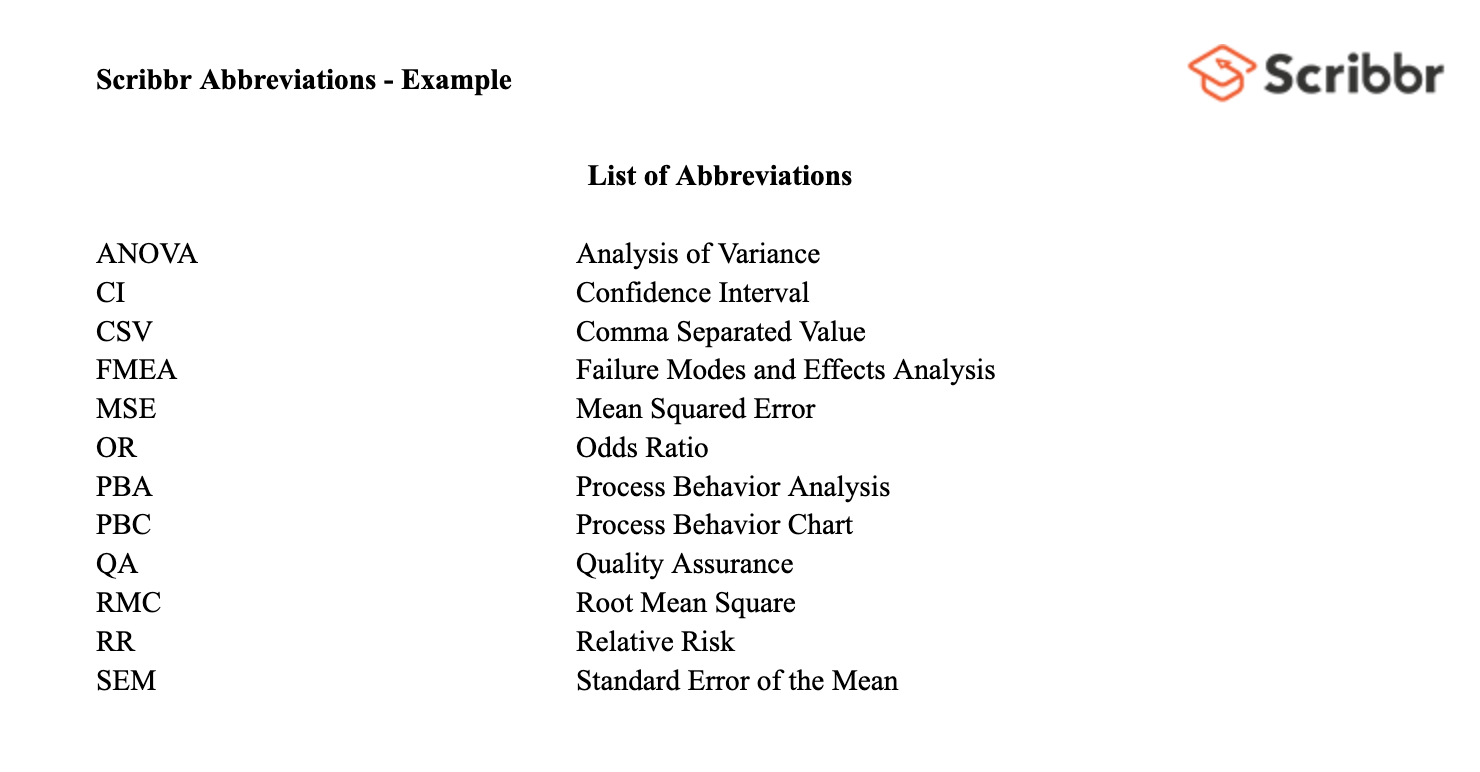
Prevent plagiarism, run a free check.
There are a few rules to keep in mind about using abbreviations in academic writing. Here are a few tips.
- Acronyms are formed using the first letter of each word in a phrase. The first time you use an acronym, write the phrase in full and place the acronym in parentheses immediately after it. You can then use the acronym throughout the rest of the text.
- The same guidance goes for abbreviations: write the explanation in full the first time you use it, then proceed with the abbreviated version.
- If you’re using very common acronyms or abbreviations, such as UK or DNA, you can abbreviate them from the first use. If you’re in doubt, just write it out in full the first time.
As well as the list of abbreviations, you can also use a list of tables and figures and a glossary for your thesis or dissertation.
Include your lists in the following order:
- List of figures and tables
- List of abbreviations
As a rule of thumb, write the explanation in full the first time you use an acronym or abbreviation. You can then proceed with the shortened version. However, if the abbreviation is very common (like UK or PC), then you can just use the abbreviated version straight away.
Be sure to add each abbreviation in your list of abbreviations !
If you only used a few abbreviations in your thesis or dissertation, you don’t necessarily need to include a list of abbreviations .
If your abbreviations are numerous, or if you think they won’t be known to your audience, it’s never a bad idea to add one. They can also improve readability, minimising confusion about abbreviations unfamiliar to your reader.
A list of abbreviations is a list of all the abbreviations you used in your thesis or dissertation. It should appear at the beginning of your document, immediately after your table of contents . It should always be in alphabetical order.
An abbreviation is a shortened version of an existing word, such as Dr for Doctor. In contrast, an acronym uses the first letter of each word to create a wholly new word, such as UNESCO (an acronym for the United Nations Educational, Scientific and Cultural Organization).
Your dissertation sometimes contains a list of abbreviations .
Cite this Scribbr article
If you want to cite this source, you can copy and paste the citation or click the ‘Cite this Scribbr article’ button to automatically add the citation to our free Reference Generator.
George, T. (2022, October 25). List of Abbreviations | Example, Template & Best Practices. Scribbr. Retrieved 27 July 2024, from https://www.scribbr.co.uk/thesis-dissertation/abbreviations-list/
Is this article helpful?
Tegan George
Other students also liked, dissertation table of contents in word | instructions & examples, dissertation title page, research paper appendix | example & templates.

How to Write a Research Proposal: (with Examples & Templates)

Table of Contents
Before conducting a study, a research proposal should be created that outlines researchers’ plans and methodology and is submitted to the concerned evaluating organization or person. Creating a research proposal is an important step to ensure that researchers are on track and are moving forward as intended. A research proposal can be defined as a detailed plan or blueprint for the proposed research that you intend to undertake. It provides readers with a snapshot of your project by describing what you will investigate, why it is needed, and how you will conduct the research.
Your research proposal should aim to explain to the readers why your research is relevant and original, that you understand the context and current scenario in the field, have the appropriate resources to conduct the research, and that the research is feasible given the usual constraints.
This article will describe in detail the purpose and typical structure of a research proposal , along with examples and templates to help you ace this step in your research journey.
What is a Research Proposal ?
A research proposal¹ ,² can be defined as a formal report that describes your proposed research, its objectives, methodology, implications, and other important details. Research proposals are the framework of your research and are used to obtain approvals or grants to conduct the study from various committees or organizations. Consequently, research proposals should convince readers of your study’s credibility, accuracy, achievability, practicality, and reproducibility.
With research proposals , researchers usually aim to persuade the readers, funding agencies, educational institutions, and supervisors to approve the proposal. To achieve this, the report should be well structured with the objectives written in clear, understandable language devoid of jargon. A well-organized research proposal conveys to the readers or evaluators that the writer has thought out the research plan meticulously and has the resources to ensure timely completion.
Purpose of Research Proposals
A research proposal is a sales pitch and therefore should be detailed enough to convince your readers, who could be supervisors, ethics committees, universities, etc., that what you’re proposing has merit and is feasible . Research proposals can help students discuss their dissertation with their faculty or fulfill course requirements and also help researchers obtain funding. A well-structured proposal instills confidence among readers about your ability to conduct and complete the study as proposed.
Research proposals can be written for several reasons:³
- To describe the importance of research in the specific topic
- Address any potential challenges you may encounter
- Showcase knowledge in the field and your ability to conduct a study
- Apply for a role at a research institute
- Convince a research supervisor or university that your research can satisfy the requirements of a degree program
- Highlight the importance of your research to organizations that may sponsor your project
- Identify implications of your project and how it can benefit the audience
What Goes in a Research Proposal?
Research proposals should aim to answer the three basic questions—what, why, and how.
The What question should be answered by describing the specific subject being researched. It should typically include the objectives, the cohort details, and the location or setting.
The Why question should be answered by describing the existing scenario of the subject, listing unanswered questions, identifying gaps in the existing research, and describing how your study can address these gaps, along with the implications and significance.
The How question should be answered by describing the proposed research methodology, data analysis tools expected to be used, and other details to describe your proposed methodology.
Research Proposal Example
Here is a research proposal sample template (with examples) from the University of Rochester Medical Center. 4 The sections in all research proposals are essentially the same although different terminology and other specific sections may be used depending on the subject.

Structure of a Research Proposal
If you want to know how to make a research proposal impactful, include the following components:¹
1. Introduction
This section provides a background of the study, including the research topic, what is already known about it and the gaps, and the significance of the proposed research.
2. Literature review
This section contains descriptions of all the previous relevant studies pertaining to the research topic. Every study cited should be described in a few sentences, starting with the general studies to the more specific ones. This section builds on the understanding gained by readers in the Introduction section and supports it by citing relevant prior literature, indicating to readers that you have thoroughly researched your subject.
3. Objectives
Once the background and gaps in the research topic have been established, authors must now state the aims of the research clearly. Hypotheses should be mentioned here. This section further helps readers understand what your study’s specific goals are.
4. Research design and methodology
Here, authors should clearly describe the methods they intend to use to achieve their proposed objectives. Important components of this section include the population and sample size, data collection and analysis methods and duration, statistical analysis software, measures to avoid bias (randomization, blinding), etc.
5. Ethical considerations
This refers to the protection of participants’ rights, such as the right to privacy, right to confidentiality, etc. Researchers need to obtain informed consent and institutional review approval by the required authorities and mention this clearly for transparency.
6. Budget/funding
Researchers should prepare their budget and include all expected expenditures. An additional allowance for contingencies such as delays should also be factored in.
7. Appendices
This section typically includes information that supports the research proposal and may include informed consent forms, questionnaires, participant information, measurement tools, etc.
8. Citations

Important Tips for Writing a Research Proposal
Writing a research proposal begins much before the actual task of writing. Planning the research proposal structure and content is an important stage, which if done efficiently, can help you seamlessly transition into the writing stage. 3,5
The Planning Stage
- Manage your time efficiently. Plan to have the draft version ready at least two weeks before your deadline and the final version at least two to three days before the deadline.
- What is the primary objective of your research?
- Will your research address any existing gap?
- What is the impact of your proposed research?
- Do people outside your field find your research applicable in other areas?
- If your research is unsuccessful, would there still be other useful research outcomes?
The Writing Stage
- Create an outline with main section headings that are typically used.
- Focus only on writing and getting your points across without worrying about the format of the research proposal , grammar, punctuation, etc. These can be fixed during the subsequent passes. Add details to each section heading you created in the beginning.
- Ensure your sentences are concise and use plain language. A research proposal usually contains about 2,000 to 4,000 words or four to seven pages.
- Don’t use too many technical terms and abbreviations assuming that the readers would know them. Define the abbreviations and technical terms.
- Ensure that the entire content is readable. Avoid using long paragraphs because they affect the continuity in reading. Break them into shorter paragraphs and introduce some white space for readability.
- Focus on only the major research issues and cite sources accordingly. Don’t include generic information or their sources in the literature review.
- Proofread your final document to ensure there are no grammatical errors so readers can enjoy a seamless, uninterrupted read.
- Use academic, scholarly language because it brings formality into a document.
- Ensure that your title is created using the keywords in the document and is neither too long and specific nor too short and general.
- Cite all sources appropriately to avoid plagiarism.
- Make sure that you follow guidelines, if provided. This includes rules as simple as using a specific font or a hyphen or en dash between numerical ranges.
- Ensure that you’ve answered all questions requested by the evaluating authority.
Key Takeaways
Here’s a summary of the main points about research proposals discussed in the previous sections:
- A research proposal is a document that outlines the details of a proposed study and is created by researchers to submit to evaluators who could be research institutions, universities, faculty, etc.
- Research proposals are usually about 2,000-4,000 words long, but this depends on the evaluating authority’s guidelines.
- A good research proposal ensures that you’ve done your background research and assessed the feasibility of the research.
- Research proposals have the following main sections—introduction, literature review, objectives, methodology, ethical considerations, and budget.

Frequently Asked Questions
Q1. How is a research proposal evaluated?
A1. In general, most evaluators, including universities, broadly use the following criteria to evaluate research proposals . 6
- Significance —Does the research address any important subject or issue, which may or may not be specific to the evaluator or university?
- Content and design —Is the proposed methodology appropriate to answer the research question? Are the objectives clear and well aligned with the proposed methodology?
- Sample size and selection —Is the target population or cohort size clearly mentioned? Is the sampling process used to select participants randomized, appropriate, and free of bias?
- Timing —Are the proposed data collection dates mentioned clearly? Is the project feasible given the specified resources and timeline?
- Data management and dissemination —Who will have access to the data? What is the plan for data analysis?
Q2. What is the difference between the Introduction and Literature Review sections in a research proposal ?
A2. The Introduction or Background section in a research proposal sets the context of the study by describing the current scenario of the subject and identifying the gaps and need for the research. A Literature Review, on the other hand, provides references to all prior relevant literature to help corroborate the gaps identified and the research need.
Q3. How long should a research proposal be?
A3. Research proposal lengths vary with the evaluating authority like universities or committees and also the subject. Here’s a table that lists the typical research proposal lengths for a few universities.
| Arts programs | 1,000-1,500 | |
| University of Birmingham | Law School programs | 2,500 |
| PhD | 2,500 | |
| 2,000 | ||
| Research degrees | 2,000-3,500 |
Q4. What are the common mistakes to avoid in a research proposal ?
A4. Here are a few common mistakes that you must avoid while writing a research proposal . 7
- No clear objectives: Objectives should be clear, specific, and measurable for the easy understanding among readers.
- Incomplete or unconvincing background research: Background research usually includes a review of the current scenario of the particular industry and also a review of the previous literature on the subject. This helps readers understand your reasons for undertaking this research because you identified gaps in the existing research.
- Overlooking project feasibility: The project scope and estimates should be realistic considering the resources and time available.
- Neglecting the impact and significance of the study: In a research proposal , readers and evaluators look for the implications or significance of your research and how it contributes to the existing research. This information should always be included.
- Unstructured format of a research proposal : A well-structured document gives confidence to evaluators that you have read the guidelines carefully and are well organized in your approach, consequently affirming that you will be able to undertake the research as mentioned in your proposal.
- Ineffective writing style: The language used should be formal and grammatically correct. If required, editors could be consulted, including AI-based tools such as Paperpal , to refine the research proposal structure and language.
Thus, a research proposal is an essential document that can help you promote your research and secure funds and grants for conducting your research. Consequently, it should be well written in clear language and include all essential details to convince the evaluators of your ability to conduct the research as proposed.
This article has described all the important components of a research proposal and has also provided tips to improve your writing style. We hope all these tips will help you write a well-structured research proposal to ensure receipt of grants or any other purpose.
References
- Sudheesh K, Duggappa DR, Nethra SS. How to write a research proposal? Indian J Anaesth. 2016;60(9):631-634. Accessed July 15, 2024. https://www.ncbi.nlm.nih.gov/pmc/articles/PMC5037942/
- Writing research proposals. Harvard College Office of Undergraduate Research and Fellowships. Harvard University. Accessed July 14, 2024. https://uraf.harvard.edu/apply-opportunities/app-components/essays/research-proposals
- What is a research proposal? Plus how to write one. Indeed website. Accessed July 17, 2024. https://www.indeed.com/career-advice/career-development/research-proposal
- Research proposal template. University of Rochester Medical Center. Accessed July 16, 2024. https://www.urmc.rochester.edu/MediaLibraries/URMCMedia/pediatrics/research/documents/Research-proposal-Template.pdf
- Tips for successful proposal writing. Johns Hopkins University. Accessed July 17, 2024. https://research.jhu.edu/wp-content/uploads/2018/09/Tips-for-Successful-Proposal-Writing.pdf
- Formal review of research proposals. Cornell University. Accessed July 18, 2024. https://irp.dpb.cornell.edu/surveys/survey-assessment-review-group/research-proposals
- 7 Mistakes you must avoid in your research proposal. Aveksana (via LinkedIn). Accessed July 17, 2024. https://www.linkedin.com/pulse/7-mistakes-you-must-avoid-your-research-proposal-aveksana-cmtwf/
Paperpal is a comprehensive AI writing toolkit that helps students and researchers achieve 2x the writing in half the time. It leverages 21+ years of STM experience and insights from millions of research articles to provide in-depth academic writing, language editing, and submission readiness support to help you write better, faster.
Get accurate academic translations, rewriting support, grammar checks, vocabulary suggestions, and generative AI assistance that delivers human precision at machine speed. Try for free or upgrade to Paperpal Prime starting at US$19 a month to access premium features, including consistency, plagiarism, and 30+ submission readiness checks to help you succeed.
Experience the future of academic writing – Sign up to Paperpal and start writing for free!
Related Reads:
- How to Paraphrase Research Papers Effectively
- How to Cite Social Media Sources in Academic Writing?
- What is the Importance of a Concept Paper and How to Write It
APA format: Basic Guide for Researchers
You may also like, how to choose a dissertation topic, how to write a phd research proposal, how to write an academic paragraph (step-by-step guide), five things authors need to know when using..., 7 best referencing tools and citation management software..., maintaining academic integrity with paperpal’s generative ai writing..., research funding basics: what should a grant proposal..., how to write an abstract in research papers..., how to write dissertation acknowledgements.
- New Hampshire
- North Carolina
- Pennsylvania
- West Virginia
- Online hoaxes
- Coronavirus
- Health Care
- Immigration
- Environment
- Foreign Policy
- Kamala Harris
- Donald Trump
- Mitch McConnell
- Hakeem Jeffries
- Ron DeSantis
- Tucker Carlson
- Sean Hannity
- Rachel Maddow
- PolitiFact Videos
- 2024 Elections
- Mostly True
- Mostly False
- Pants on Fire
- Biden Promise Tracker
- Trump-O-Meter
- Latest Promises
- Our Process
- Who pays for PolitiFact?
- Advertise with Us
- Suggest a Fact-check
- Corrections and Updates
- Newsletters
Stand up for the facts!
Our only agenda is to publish the truth so you can be an informed participant in democracy. We need your help.
I would like to contribute

- Border Security
- Republican National Committee
Vice President Kamala Harris waves as she boards Air Force Two after a campaign event July 23, 2024, in Milwaukee. (AP)

'Border czar'? Kamala Harris assigned to tackle immigration's causes, not border security
If your time is short.
In March 2021, President Joe Biden tasked Vice President Kamala Harris with working alongside officials in Guatemala, El Salvador and Honduras to address the issues driving people to leave those countries and come to the United States.
The Biden-Harris administration said it would focus on five key issues: economic insecurity, corruption, human rights, criminal gang violence and gender-based violence.
Border security and management is the Homeland Security secretary’s responsibility.
Vice President Kamala Harris might soon get a new official title: 2024 Democratic presidential nominee. In the meantime, Republicans have revived a title they gave her in 2021: "border czar."
Claims that President Joe Biden named Harris the "border czar" and that she is responsible for overseeing U.S. border enforcement gained prominence at the Republican National Convention as the party sought to link her to his immigration policy.
The refrain intensified once Biden dropped out of the race and endorsed Harris. It was echoed in ads and by Trump campaign surrogates, including Ohio Sen. J.D. Vance , the Republican vice presidential nominee.
"Here’s Biden appointing Kamala Harris to be his border czar to deal with illegal immigration," a narrator says in a video the Republican National Committee posted on its X account, @GOP. "And here are a record number of illegal immigrants — 10 million and counting — flooding over the border after Harris was put in charge of stopping illegal immigration."
We’ve repeatedly fact-checked claims about the number of people entering the U.S. illegally under Biden. The federal data tracks how many times officials encountered a person trying to cross the southern border, but it doesn’t reflect the number of people let in. And if one person tries to cross the border multiple times, that counts as multiple encounters, even if it’s the same person.
For this fact-check, we’re focused on the scope of Harris’ border responsibilities.
"Border Czar Kamala Harris' reversal of President Trump's immigration policies has created an unprecedented and illegal immigration, humanitarian and national security crisis on our southern border," Trump campaign National Press Secretary Karoline Leavitt told PolitiFact in a statement.
But Biden didn’t put Harris in charge of overseeing border security.
In a meeting with Harris in March 2021 , Biden said Harris would lead U.S. diplomatic efforts and work with officials in Mexico, Guatemala, El Salvador and Honduras to stem migration to the U.S. Biden said that when he was vice president, he "got a similar assignment" and that the Obama administration secured $700 million to help countries in Central America.
"One of the ways we learned is that if you deal with the problems in country, it benefits everyone. It benefits us, it benefits the people, and it grows the economies there," Biden said then.
Biden asked Harris "to be the chief diplomatic officer with Central American countries" and address the root causes that make people leave their home countries, said Michelle Mittelstadt, communications director for the Migration Policy Institute, a nonpartisan think tank.
Managing the border "has always been" the Homeland Security secretary’s role, Mittelstadt said.
Biden tasked Harris with addressing the root causes influencing people’s decisions to migrate to the United States.
"I’ve asked her … to lead our efforts with Mexico and the Northern Triangle and the countries that help — are going to need help in stemming the movement of so many folks, stemming the migration to our southern border," Biden said in March 2021.
Biden held a similar role as vice president to former President Barack Obama. In a 2015 New York Times opinion piece, Biden said he would work with the Northern Triangle’s leaders on security, anti-corruption and investment efforts in the region.
"Donald Trump’s administration didn’t really sustain this strategy, but what Harris sought to revive in 2021 ran along the same lines," said Adam Isacson, defense oversight director at Washington Office on Latin America, a group advocating for human rights in the Americas.
Within weeks of Biden’s remarks about Harris’ role, Republicans including Texas Gov. Greg Abbott and Rep. Steve Scalise, R-La., began calling Harris the " border czar " often in tandem with pointing out she had not yet been to the border.
In April 2021, when a reporter asked Harris whether she would visit the border, she said that her role is addressing the factors that make people leave their home countries, not managing the border.
Featured Fact-check

"The president has asked (Homeland Security) Secretary (Alejandro) Mayorkas to address what is going on at the border. And he has been working very hard at that, and it’s showing some progress because of his hard work," Harris said at an event . "I have been asked to lead the issue of dealing with root causes in the Northern Triangle, similar to what the then-vice president did many years ago."
Harris said she’d focus on economic struggles, violence, corruption and food insecurity in the countries.
In June 2021, Harris visited El Paso, Texas, with Mayorkas. They outlined their responsibilities to reporters. Harris said she was addressing "the root causes of migration, predominantly out of Central America," and Mayorkas said, "It is my responsibility as the Secretary of Homeland Security to address the security and management of our border."

But this distinction didn’t stop critics from linking Harris with U.S.-Mexico border security.
"The administration’s messaging on this in mid-2021 was not as clear as it should have been," Isacson said. "But at no time did Harris or the White House state that her duties included the U.S.-Mexico border, or border security."
Immigration experts said it’s hard to measure Harris’ success in her role, and that a "root causes" approach implies that the results will be seen long term, not immediately.
In July 2021, the administration published a strategy , with Harris writing the lead message, for confronting the factors that drive migration in Central America. The plan focused on economic insecurity, corruption, human rights, criminal gang violence and gender-based violence.
In March 2024, the administration said it secured more than $5.2 billion in private sector investments to the region. However, only about $1 billion has been distributed, the Partnership for Central America, a group working with the administration, reported .
The White House said the investments have generated more than 70,000 new jobs in Guatemala, Honduras and El Salvador, provided job training to 1 million people and expanded digital access to 4.5 million people.
"Still, her engagement on this issue has been sporadic," Isacson said. "She has not traveled very often to the region or otherwise sought to make ‘root causes in Central America’ a central theme of her vice presidency."
Illegal immigration at the U.S. southern border from Guatemala, Honduras and El Salvador has dropped since 2021. Encounters with people from other countries, Venezuela, have risen .
"But it’s hard to prove that U.S. assistance is a central reason" for the Northern Triangle countries’ decline, Isacson said.
The issues pushing people to leave Central American countries "are extremely complex and require deep restructuring of so much in those societies," said Cecilia Menjivar, a sociology professor at the University of California, Los Angeles who specializes on immigration. "So it’s very difficult for one person to change all that, even if it is a powerful person."
Immigration patterns at the U.S.-Mexico border have more to do with conditions in Latin American countries than "any U.S. policy," Mittelstadt said.
For example, a humanitarian crisis in Venezuela has displaced nearly 8 million people since 2014, according to the United Nations. Political, economic and security crises in Cuba, Nicaragua, Haiti and Ecuador have also led to more migration from these countries, Mittelstadt said.
In contrast, immigration encounters with people from El Salvador have dropped in past years, partly because of the country’s crime crackdown .
The Republican National Committee said Biden appointed Harris "to be his border czar to deal with illegal immigration...Harris was put in charge of stopping illegal immigration."
Biden tasked Harris with addressing the root causes that drive migration to the United States. He did not task her with controlling who and how many people enter the southern U.S. border. That's the Homeland Security secretary’s responsibility.
Experts say that seeing the results of addressing root causes driving people out of Guatemala, El Salvador and Honduras — violence, economic insecurity and corruption — takes time.
The statement contains an element of truth, but it ignores critical facts that would give a different impression. We rate it Mostly False.
Read About Our Process
The Principles of the Truth-O-Meter
Our Sources
Truth Social, post , July 22, 2024
The Hill, House Republicans tee up vote condemning Harris as ‘border czar’ , July 23, 2024
C-SPAN, Sen. J.D. Vance campaign rally in Radford, Virginia , July 22, 2024
GOP, post on X , July 21, 2024
PolitiFact, Francis Suarez’s misleading claim about millions of migrants getting free cellphones, plane tickets , July 28, 2024
PolitiFact, There aren’t 20 million to 30 million immigrants in the U.S. illegally, as Sen. Marco Rubio claimed , June 11, 2024
The White House, Remarks by President Biden and Vice President Harris in a meeting on immigration , March 24, 2021
PolitiFact, Central America and the root causes of migration to the US , June 7, 2021
The New York Times, Joe Biden: A Plan for Central America , Jan. 29, 2015
The White House, Remarks by Vice President Harris at virtual roundtable of experts on the Northern Triangle , April 14, 2021
The White House, Remarks by Vice President Harris, Secretary of Homeland Security Mayorkas, Chairman Durbin, and Representative Escobar in press gaggle , June 25, 2021
Fox News, Obama-era DHS secretary: 'There's a real problem' when you have 'bipartisan outrage' , July 23, 2024
The White House, FACT SHEET: Strategy to address the root causes of migration in Central America , July 29, 2021
The White House, FACT SHEET: Vice President Harris announces public-private partnership has generated more than $5.2 billion in private sector commitments for Northern Central America , March 25, 2024
Migration Policy Institute, Shifting patterns and policies reshape migration to U.S.-Mexico border in major ways in 2023 , October 2023
United Nations High Commissioner for Refugees, Venezuela crisis explained , April 17, 2024
PolitiFact, Donald Trump fact-check: 2024 RNC speech in Milwaukee full of falsehoods about immigrants, economy , July 19, 2024
CBS News, The facts about Kamala Harris' role on immigration in the Biden administration , July 23, 2024
Email interview, Michelle Mittelstadt, communications director for the Migration Policy Institute, July 22, 2024
Email interview, Adam Isacson, defense oversight director at Washington Office on Latin America, July 22, 2024
Email interview, Henry Ziemer, research associate for the Center for Strategic and International Studies, July 22, 2024
Email interview, Cecilia Menjivar, sociology professor at the University of California, Los Angeles, July 22, 2024
Statement, Karoline Leavitt, Trump campaign national press secretary, July 23, 2024
Browse the Truth-O-Meter
More by maria ramirez uribe.

'Border czar'? Kamala Harris assigned to tackle immigration's causes, not border security

Support independent fact-checking. Become a member!
These are the 10 best-performing stocks of all time
- New research identifies the 10 best-performing US stocks since 1926.
- Of 29,000 US stocks traded since 1926, most had negative returns, but top performers showed consistent gains.
- The study affirms the importance of "time in the market," according to its author, Hendrik Bessembinder.

A new research paper has examined all 29,078 US stocks that have existed since 1926 and identified the top 10 performers of all time.
These stocks, some of them household names, have generated enormous wealth for those who purchased even just one share of the company and held on to it for nearly 100 years.
Of course, identifying the 10 best-performing stocks for the next 100 years is nearly impossible, as the paper's author points out.
"The majority (51.6%) of these stocks had negative cumulative returns," finance professor Hendrik Bessembinder of Arizona State University wrote.
But with a healthy dose of luck, $1 invested in 1926 would have been worth $2.67 million at the end of 2023, assuming it was invested in the right company.
Bessembinder also observed that the 10 best-performing stocks delivered consistently modest annualized gains, reinforcing the slow and steady mantra championed by long-term investors.
"Annualized compound returns to these top performers relatively were modest, averaging 13.47% across the top seventeen stocks, thereby affirming the importance of 'time in the market," Bessembinder wrote.
From soda to cigarettes to computers and airplanes, these are the 10 top-performing US stocks since 1926, according to the paper, which assumed that dividends were reinvested.
Ticker: PEP Return of $1 invested : $86,360 Investment date: December 31, 1925 - December 29, 2023
Ticker: KO Return of $1 invested : $123,724 Investment date: December 31, 1925 - December 29, 2023
- S&P Global
Ticker: SPGI Return of $1 invested : $128,787 Investment date: February 14, 1929 - December 29, 2023
Ticker: ETN Return of $1 invested : $151,173 Investment date: December 31, 1925 - December 29, 2023
- International Business Machines
Ticker: IBM Return of $1 invested : $175,437 Investment date: December 31, 1925- December 29, 2023 5. Boeing
Ticker: BA Return of $1 invested : $212,206 Investment date: September 5, 1934 - December 29, 2023
- General Dynamics
Ticker: GD Return of $1 invested : $220,850 Investment date: January 28, 1926 - December 29, 2023
- Kansas City Southern
Ticker: Delisted after 2021 acquisition by Canadian Pacific Return of $1 invested : $361,757 Investment date: December 31, 1925 - December 13, 2021
- Vulcan Materials
Ticker: VMC Return of $1 invested : $393,492 Investment date: December 31, 1925- December 29, 2023
- Altria Group
Ticker: MO Return of $1 invested : $2,655,290 Investment date: December 31, 1925 - December 29, 2023
- Main content
Suggestions or feedback?
MIT News | Massachusetts Institute of Technology
- Machine learning
- Sustainability
- Black holes
- Classes and programs
Departments
- Aeronautics and Astronautics
- Brain and Cognitive Sciences
- Architecture
- Political Science
- Mechanical Engineering
Centers, Labs, & Programs
- Abdul Latif Jameel Poverty Action Lab (J-PAL)
- Picower Institute for Learning and Memory
- Lincoln Laboratory
- School of Architecture + Planning
- School of Engineering
- School of Humanities, Arts, and Social Sciences
- Sloan School of Management
- School of Science
- MIT Schwarzman College of Computing
Large language models don’t behave like people, even though we may expect them to
Press contact :, media download.

*Terms of Use:
Images for download on the MIT News office website are made available to non-commercial entities, press and the general public under a Creative Commons Attribution Non-Commercial No Derivatives license . You may not alter the images provided, other than to crop them to size. A credit line must be used when reproducing images; if one is not provided below, credit the images to "MIT."

Previous image Next image
One thing that makes large language models (LLMs) so powerful is the diversity of tasks to which they can be applied. The same machine-learning model that can help a graduate student draft an email could also aid a clinician in diagnosing cancer.
However, the wide applicability of these models also makes them challenging to evaluate in a systematic way. It would be impossible to create a benchmark dataset to test a model on every type of question it can be asked.
In a new paper , MIT researchers took a different approach. They argue that, because humans decide when to deploy large language models, evaluating a model requires an understanding of how people form beliefs about its capabilities.
For example, the graduate student must decide whether the model could be helpful in drafting a particular email, and the clinician must determine which cases would be best to consult the model on.
Building off this idea, the researchers created a framework to evaluate an LLM based on its alignment with a human’s beliefs about how it will perform on a certain task.
They introduce a human generalization function — a model of how people update their beliefs about an LLM’s capabilities after interacting with it. Then, they evaluate how aligned LLMs are with this human generalization function.
Their results indicate that when models are misaligned with the human generalization function, a user could be overconfident or underconfident about where to deploy it, which might cause the model to fail unexpectedly. Furthermore, due to this misalignment, more capable models tend to perform worse than smaller models in high-stakes situations.
“These tools are exciting because they are general-purpose, but because they are general-purpose, they will be collaborating with people, so we have to take the human in the loop into account,” says study co-author Ashesh Rambachan, assistant professor of economics and a principal investigator in the Laboratory for Information and Decision Systems (LIDS).
Rambachan is joined on the paper by lead author Keyon Vafa, a postdoc at Harvard University; and Sendhil Mullainathan, an MIT professor in the departments of Electrical Engineering and Computer Science and of Economics, and a member of LIDS. The research will be presented at the International Conference on Machine Learning.
Human generalization
As we interact with other people, we form beliefs about what we think they do and do not know. For instance, if your friend is finicky about correcting people’s grammar, you might generalize and think they would also excel at sentence construction, even though you’ve never asked them questions about sentence construction.
“Language models often seem so human. We wanted to illustrate that this force of human generalization is also present in how people form beliefs about language models,” Rambachan says.
As a starting point, the researchers formally defined the human generalization function, which involves asking questions, observing how a person or LLM responds, and then making inferences about how that person or model would respond to related questions.
If someone sees that an LLM can correctly answer questions about matrix inversion, they might also assume it can ace questions about simple arithmetic. A model that is misaligned with this function — one that doesn’t perform well on questions a human expects it to answer correctly — could fail when deployed.
With that formal definition in hand, the researchers designed a survey to measure how people generalize when they interact with LLMs and other people.
They showed survey participants questions that a person or LLM got right or wrong and then asked if they thought that person or LLM would answer a related question correctly. Through the survey, they generated a dataset of nearly 19,000 examples of how humans generalize about LLM performance across 79 diverse tasks.
Measuring misalignment
They found that participants did quite well when asked whether a human who got one question right would answer a related question right, but they were much worse at generalizing about the performance of LLMs.
“Human generalization gets applied to language models, but that breaks down because these language models don’t actually show patterns of expertise like people would,” Rambachan says.
People were also more likely to update their beliefs about an LLM when it answered questions incorrectly than when it got questions right. They also tended to believe that LLM performance on simple questions would have little bearing on its performance on more complex questions.
In situations where people put more weight on incorrect responses, simpler models outperformed very large models like GPT-4.
“Language models that get better can almost trick people into thinking they will perform well on related questions when, in actuality, they don’t,” he says.
One possible explanation for why humans are worse at generalizing for LLMs could come from their novelty — people have far less experience interacting with LLMs than with other people.
“Moving forward, it is possible that we may get better just by virtue of interacting with language models more,” he says.
To this end, the researchers want to conduct additional studies of how people’s beliefs about LLMs evolve over time as they interact with a model. They also want to explore how human generalization could be incorporated into the development of LLMs.
“When we are training these algorithms in the first place, or trying to update them with human feedback, we need to account for the human generalization function in how we think about measuring performance,” he says.
In the meanwhile, the researchers hope their dataset could be used a benchmark to compare how LLMs perform related to the human generalization function, which could help improve the performance of models deployed in real-world situations.
“To me, the contribution of the paper is twofold. The first is practical: The paper uncovers a critical issue with deploying LLMs for general consumer use. If people don’t have the right understanding of when LLMs will be accurate and when they will fail, then they will be more likely to see mistakes and perhaps be discouraged from further use. This highlights the issue of aligning the models with people's understanding of generalization,” says Alex Imas, professor of behavioral science and economics at the University of Chicago’s Booth School of Business, who was not involved with this work. “The second contribution is more fundamental: The lack of generalization to expected problems and domains helps in getting a better picture of what the models are doing when they get a problem ‘correct.’ It provides a test of whether LLMs ‘understand’ the problem they are solving.”
This research was funded, in part, by the Harvard Data Science Initiative and the Center for Applied AI at the University of Chicago Booth School of Business.
Share this news article on:
Related links.
- Ashesh Rambachan
- Laboratory for Information and Decision Systems
- Department of Electrical Engineering and Computer Science
- Department of Economics
Related Topics
- Computer science and technology
- Artificial intelligence
- Human-computer interaction
- Laboratory for Information and Decision Systems (LIDS)
- School of Humanities Arts and Social Sciences
Related Articles
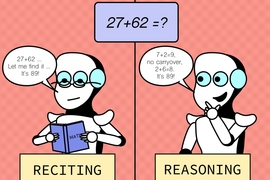
Reasoning skills of large language models are often overestimated

Technique improves the reasoning capabilities of large language models

Natural language boosts LLM performance in coding, planning, and robotics

Multi-AI collaboration helps reasoning and factual accuracy in large language models
Previous item Next item
More MIT News

Edgerton Center hosts workshop for deaf high school students in STEM
Read full story →

MIT Global SCALE Network expands by adding center at Loughborough University

New transistor’s superlative properties could have broad electronics applications

When learning at MIT means studying thousands of miles away

Flying high to enable sustainable delivery, remote care

Professor Emeritus Ralph Gakenheimer, mobility planner and champion of international development, dies at 89
- More news on MIT News homepage →
Massachusetts Institute of Technology 77 Massachusetts Avenue, Cambridge, MA, USA
- Map (opens in new window)
- Events (opens in new window)
- People (opens in new window)
- Careers (opens in new window)
- Accessibility
- Social Media Hub
- MIT on Facebook
- MIT on YouTube
- MIT on Instagram

IMAGES
VIDEO
COMMENTS
List of Abbreviations | Example, Template & Best Practices. Published on May 23, 2022 by Tegan George.Revised on July 18, 2023. A list of abbreviations is an alphabetical list of abbreviations that you can add to your thesis or dissertation.If you choose to include it, it should appear at the beginning of your document, just after your table of contents.
Abbreviations and acronyms are common in academic writing, but they need to be used correctly and consistently. This web page provides guidelines and examples on how to abbreviate words, phrases, names, and titles in your paper. You will also learn how to avoid confusion and ambiguity with abbreviations and acronyms.
Abbreviations are commonly used in research manuscripts as they can help make highly complex technical writing more concise and easier to read. However, they can also cause a lot of confusion, and make communication unclear if they are not used with caution. This article takes a look at some of the common errors that researchers make in the usage of abbreviations and explains how to avoid them.
Academics often use abbreviations in research writing to meet strict word limits, but this is also where mistakes occur. This article explains the most common abbreviation errors with expert tips on using abbreviations in research correctly. Read on!
How To Use Abbreviations in Academic Writing. November 3, 2022 | Blog Cheat sheet. No time to read? Here's the short version: Avoid contractions like won't, can't, they're, it's.; The first time you mention a phrase that can be abbreviated, spell it out in full and provide the abbreviation in parentheses.
Using abbreviations can be an effective way to avoid repeating lengthy, technical terms throughout a piece of writing, but they should be used sparingly to prevent your text from becoming difficult to read.
Time see Publication Manual Section 6.28 on time abbreviations • Use the time abbreviations shown in the table when they appearwith a numeral. • However, do not abbreviate the following larger units of time, even with numerals: ° days ° weeks ° months ° years Abbreviation Meaning hr hour min minute s seconds ms milisecond Latin see Publication Manual Section 6.29 on Latin
In "Becoming a Ruthless Editor" (Nicoll, 7), I discussed how to shorten a manuscript significantly.One of the suggestions I offered at the end—when the paring down is getting to the critical stage—is to change selected phrases to acronyms.
Examples: PCRs (not PCR's)BACs (not BAC's)Drs. (not Dr's)rbc's (not rbcs)Exception 1: Plurals of some abbreviations, particularly in references, are not formed by merely adding an s.. Examples: p for page and pp for pages (not ps or pgs)l for line and ll for lines (not ls)c for column and cc for columns (not cs)Exception 2: Singular and plural units of measure are abbreviated the same.
In APA, abbreviations should be limited to instances when a) the abbreviation is standard and will not interfere with the reader's understanding and b) if space and repetition can be greatly avoided through abbreviation.
Avoid e.g. and i.e., instead use for example and for instance.. Avoid etc.There isn't really an alternative, so rewrite the sentence. Avoid dept, govt.Use department, government.. Avoid NB, instead use note that.. Avoid vs or v, instead use versus or against (except in Law reports or cases)
Microsoft Word can automatically create a List of Abbreviations and Acronyms. If you use a lot of abbreviations and acronyms in your thesis — and even if you only use a few — there is no reason not to include a list.
What are Abbreviations and Acronyms? An abbreviation is a shortened version of a term or phrase, e.g. kg for kilogram or Dr. for doctor. An acronym is a type of abbreviation constructed from the first letters of a term, e.g. FRP for Fibre Reinforced Polymer or STEM for Science, Technology, Engineering and Maths.
MLA (Modern Language Association) style is most commonly used to write papers and cite sources within the liberal arts and humanities. This resource, updated to reflect the MLA Handbook (9th ed.), offers examples for the general format of MLA research papers, in-text citations, endnotes/footnotes, and the Works Cited page.
Abbreviations Definitions; DNA: Deoxyribonucleic acid: NASA: National Aeronautics and Space Administration: PBA: Process Behaviour Analysis: QA: Quality Assurance
Whether you're working on a thesis or a research paper, abbreviations and acronyms are difficult to avoid in academic writing, which is why it's important that you know how to use them properly. Here's a quick primer. 1. Spell the word or phrase in full at first mention When you first use the term that you
Journal Titles and Abbreviations A Acc. Chem. Res. ACH - Models Chem. ACI Mater. J. ACS Symp. Ser. Acta Biochim. Pol. Acta Biotechnol. Acta Chem. Scand.
Acronyms and Abbreviations. There are various ways of placing acronyms and abbreviations in a dissertation. While using acronyms formed by combining the first letter of each word from a phrase, you should write that phrase in its full form and then write the abbreviation in parenthesis right after that.
The SBL Handbook of Style offers two extensive lists of abbreviations for journals, series, and other standard reference works. The first abbreviation list is alphabetized by source (SBLHS 8.4.1) and the second by abbreviation (SBLHS 8.4.2).If the work cited is in these lists, you may use the standard abbreviation provided.
A dissertation prospectus or proposal describes what or who you plan to research for your dissertation. It delves into why, when, where, and how you will do your research, as well as helps you choose a type of research to pursue. You should also determine whether you plan to pursue qualitative or quantitative methods and what your research design will look like.
Explore popular shortcuts to use Research abbreviation and the short forms with our easy guide. Review the list of 9 top ways to abbreviate Research. Updated in 2023 to ensure the latest compliance and practices
For a complete list of Common Scholarly Abbreviations, please see Section 7.4 in the 6th edition of the MLA Handbook for Writers of Research Papers.. Abbreviations of Degrees. Note: When documenting sources using MLA style, the normal punctuation is omitted for degrees when used in parentheses, tables, works cited, footnotes, endnotes, etc.
List of Abbreviations | Example, Template & Best Practices. Published on 23 May 2022 by Tegan George.Revised on 25 October 2022. A list of abbreviations is an alphabetical list of abbreviations that you can add to your thesis or dissertation. If you choose to include it, it should appear at the beginning of your document, just after your table of contents.
Learn how to write an effective PhD research proposal with practical tips and a clear structure. Understand the importance of a proposal, its key elements, and strategies for presenting your research ideas compellingly. Gain insights to make your proposal stand out and improve your chances of securing admissions and funding.
Before conducting a study, a research proposal should be created that outlines researchers' plans and methodology and is submitted to the concerned evaluating organization or person. Creating a research proposal is an important step to ensure that researchers are on track and are moving forward as intended. A research proposal can be defined as a detailed plan or blueprint for the proposed ...
There are still important disanalogies between our current empirical setup and the ultimate problem of aligning superhuman models. For example, it may be easier for future models to imitate weak human errors than for current strong models to imitate current weak model errors, which could make generalization harder in the future.
Stand up for the facts! Our only agenda is to publish the truth so you can be an informed participant in democracy. We need your help. More Info
A new research paper has examined all 29,078 US stocks that have existed since 1926 and identified the top 10 performers of all time.. These stocks, some of them household names, have generated ...
People generalize to form beliefs about a large language model's performance based on what they've seen from past interactions. When an LLM is misaligned with a person's beliefs, even an extremely capable model may fail unexpectedly when deployed in a real-world situation.
www.iiss.org